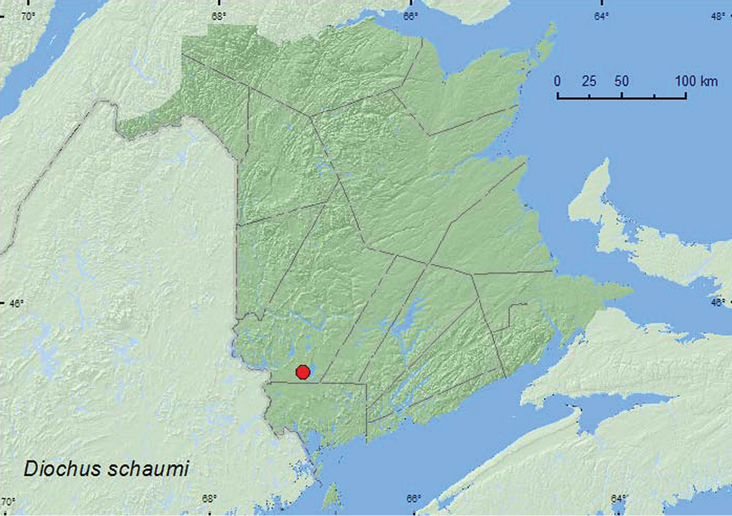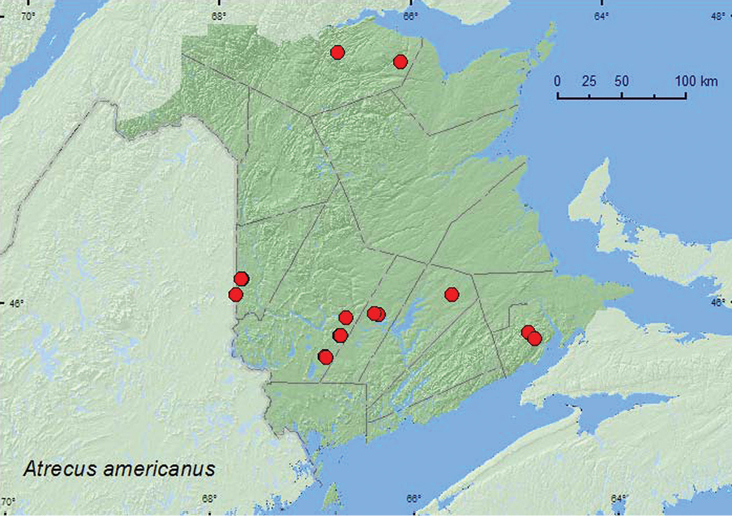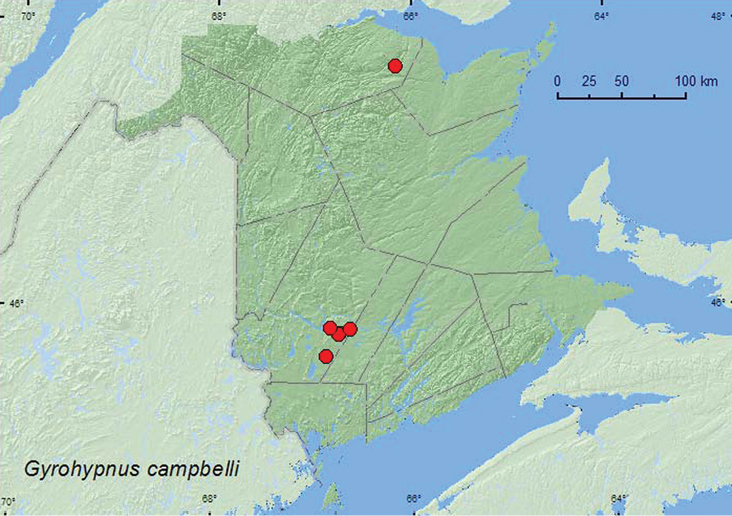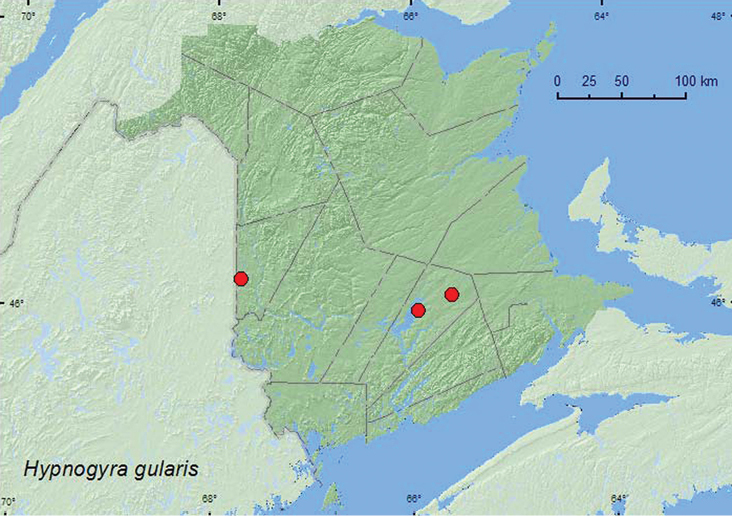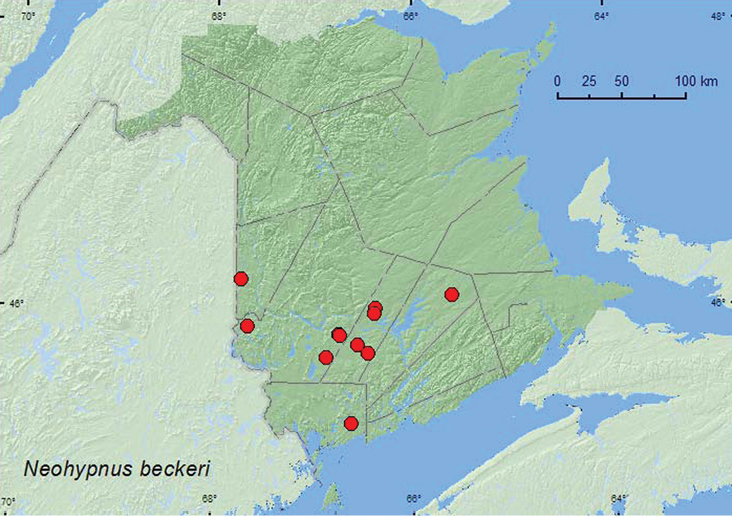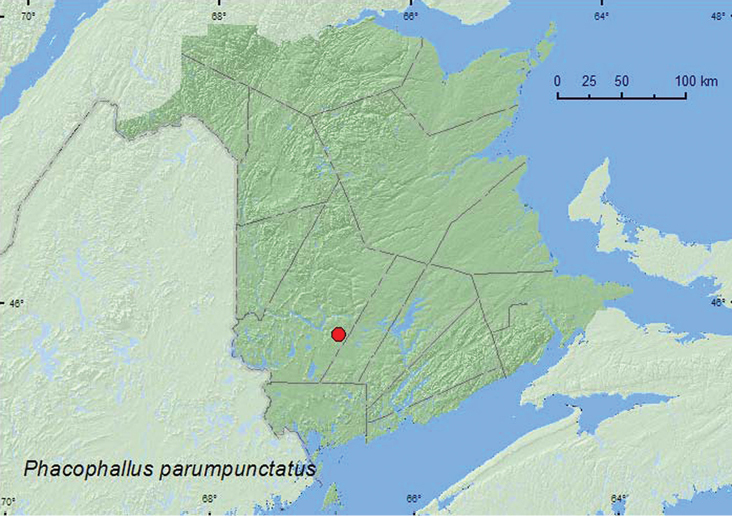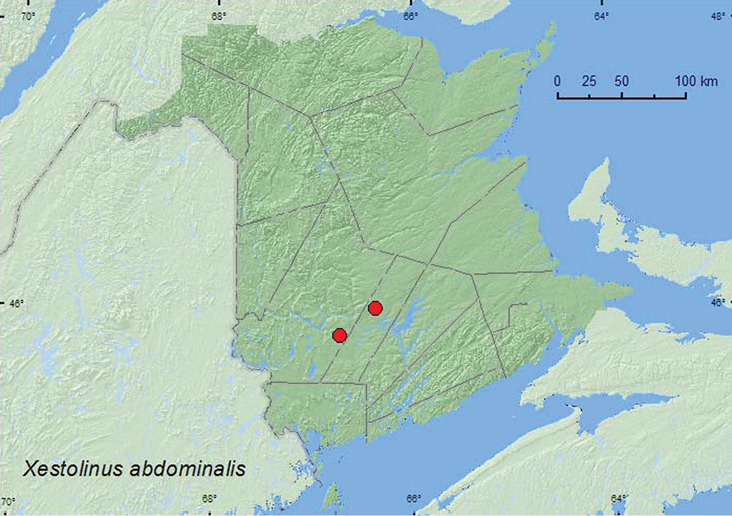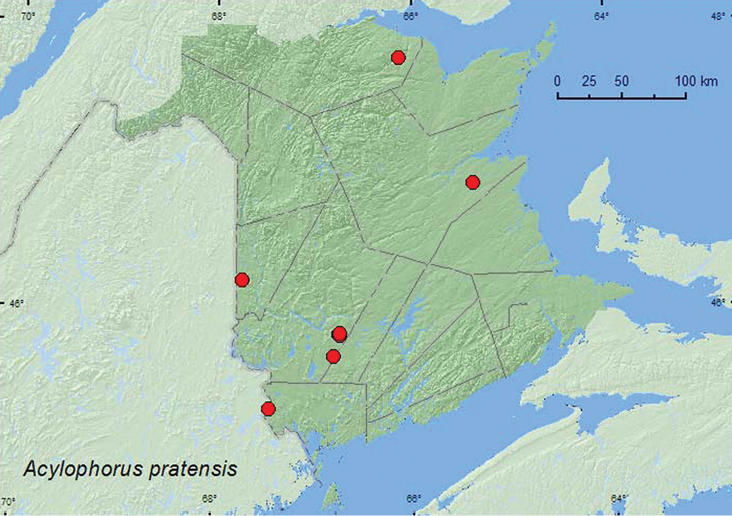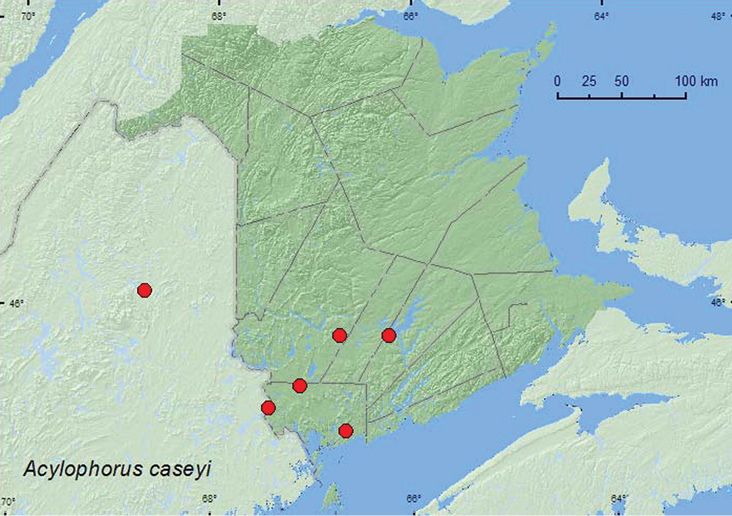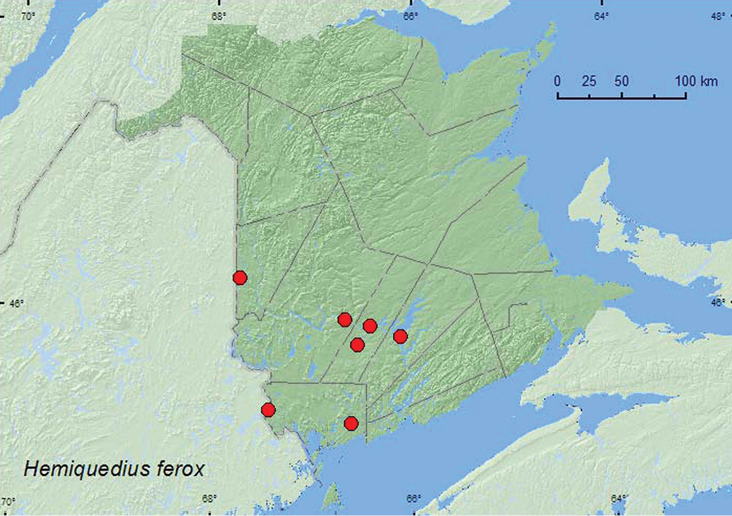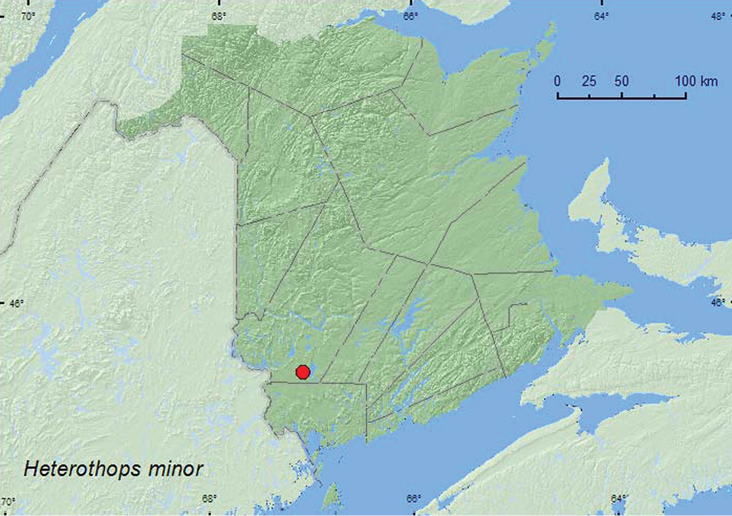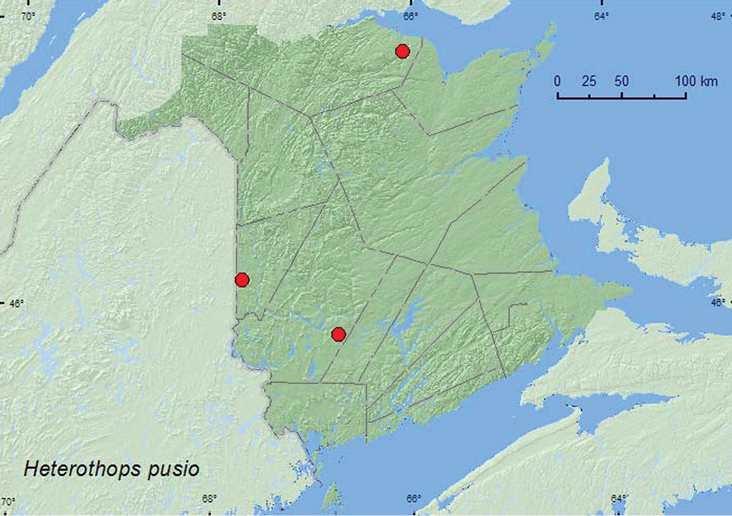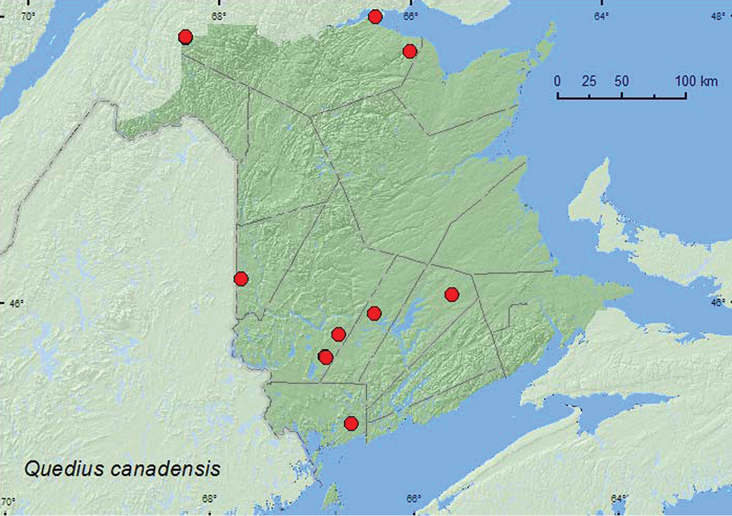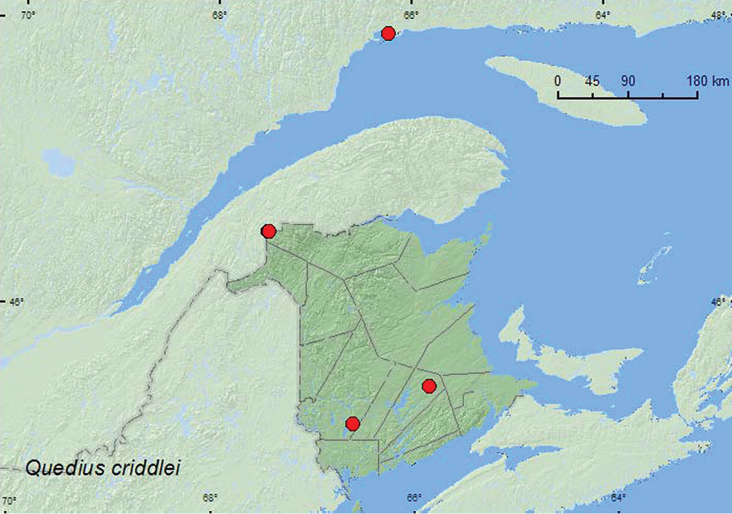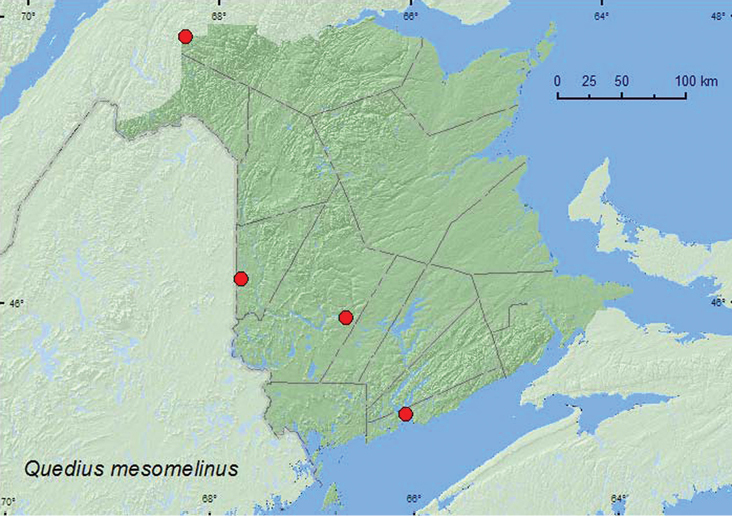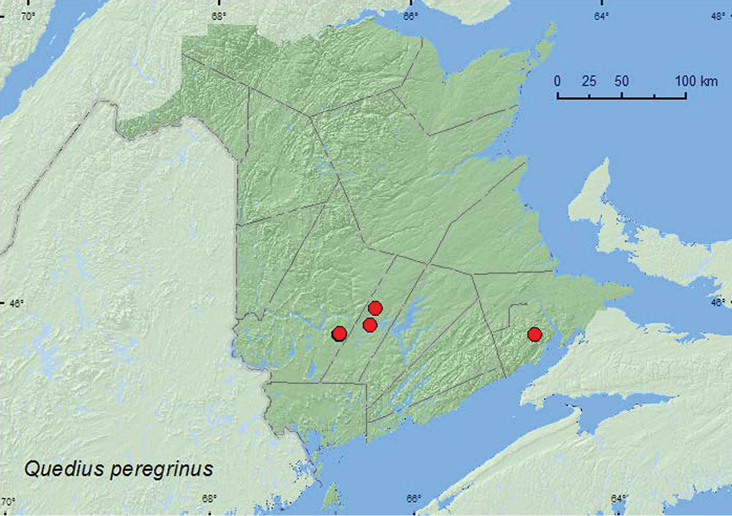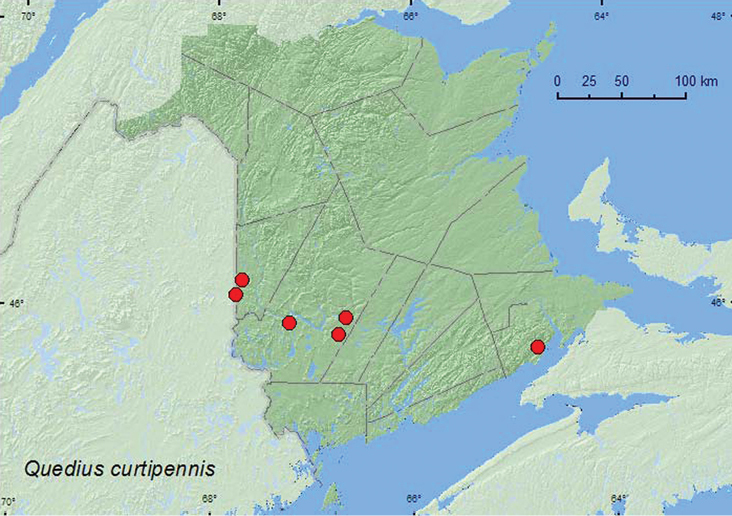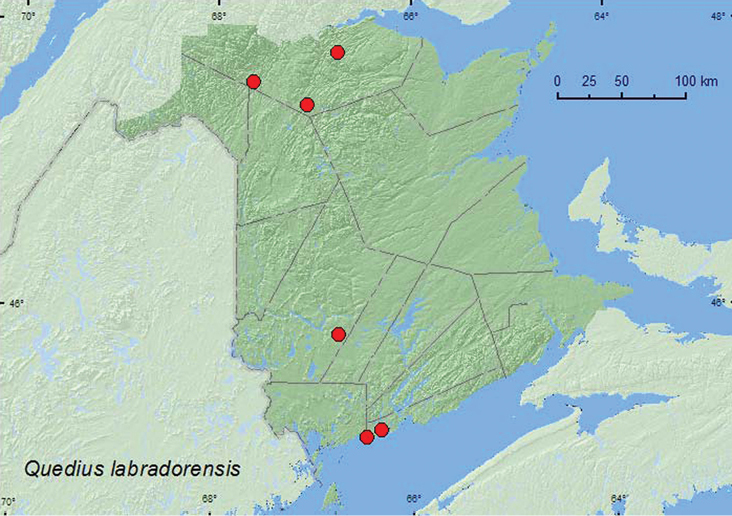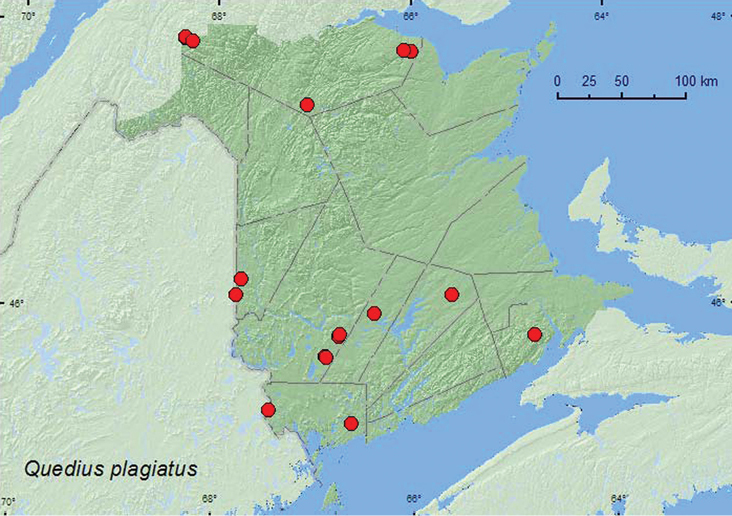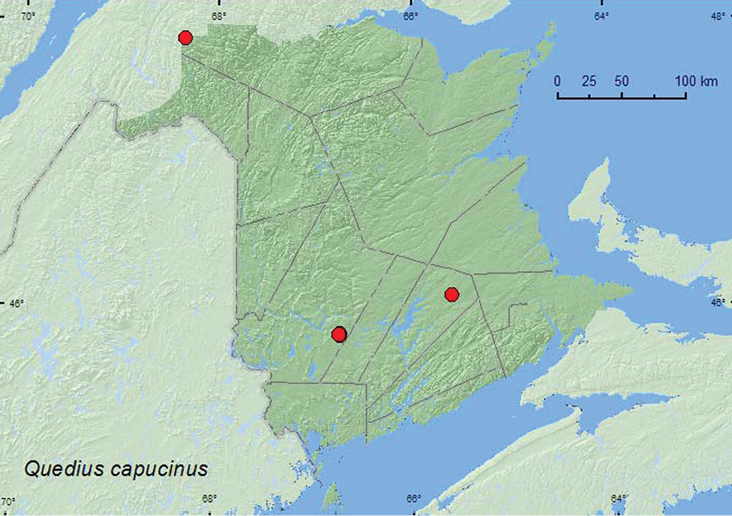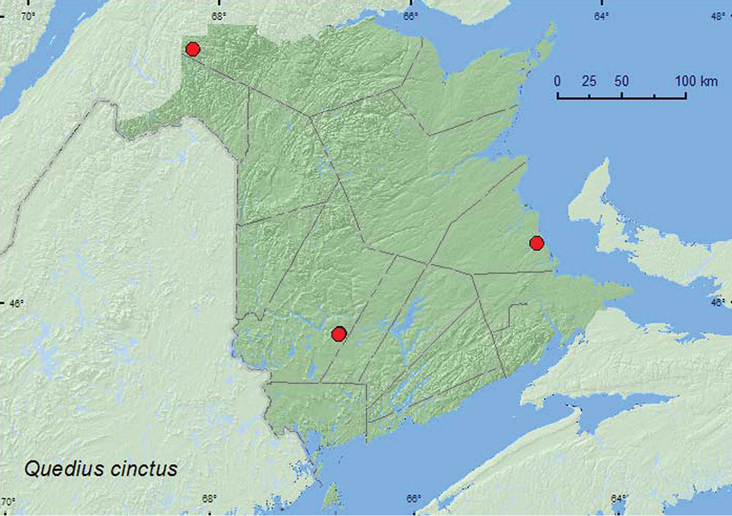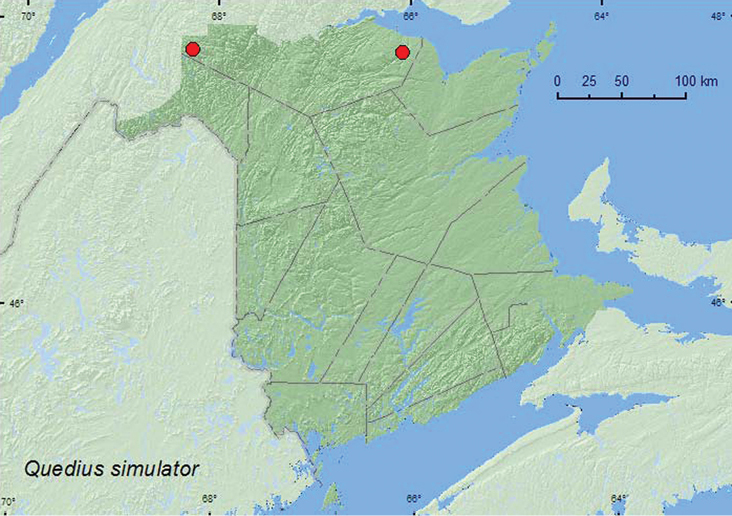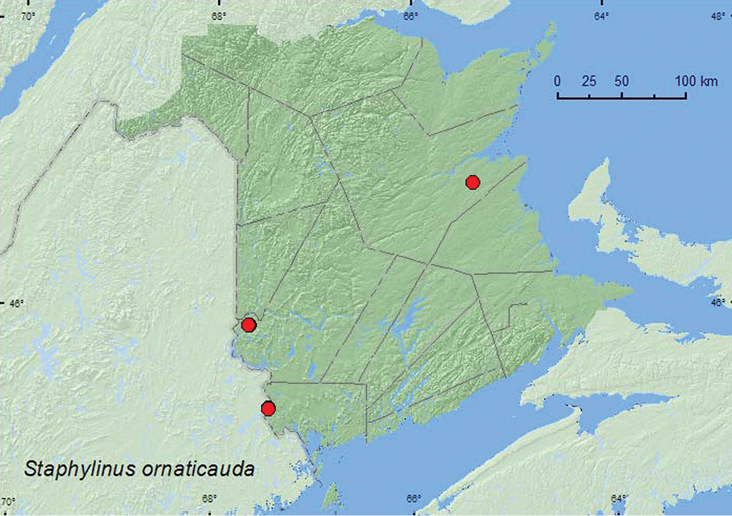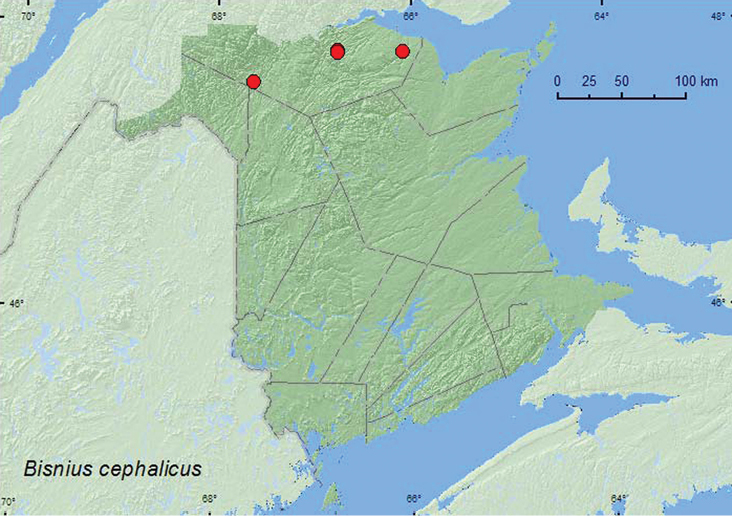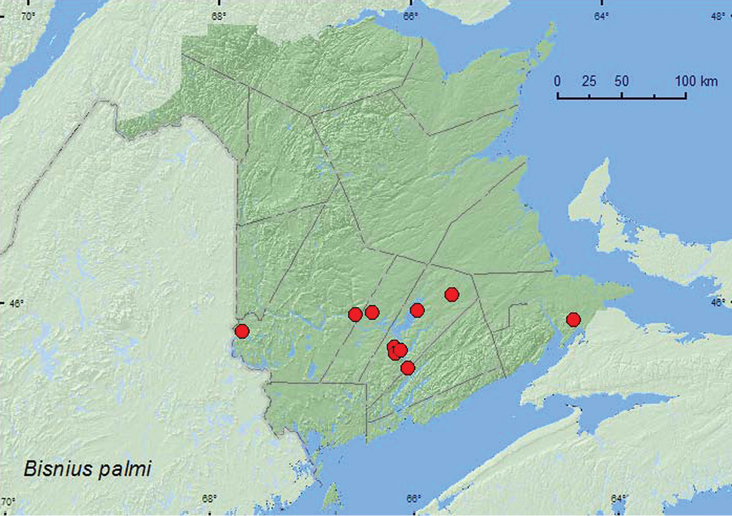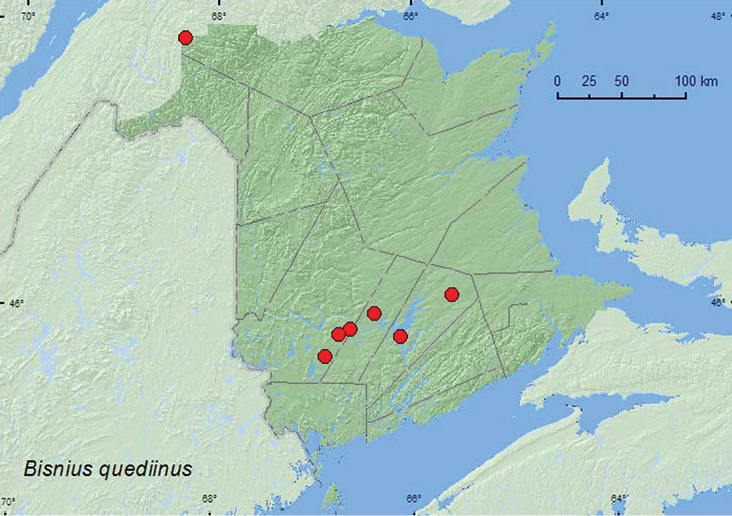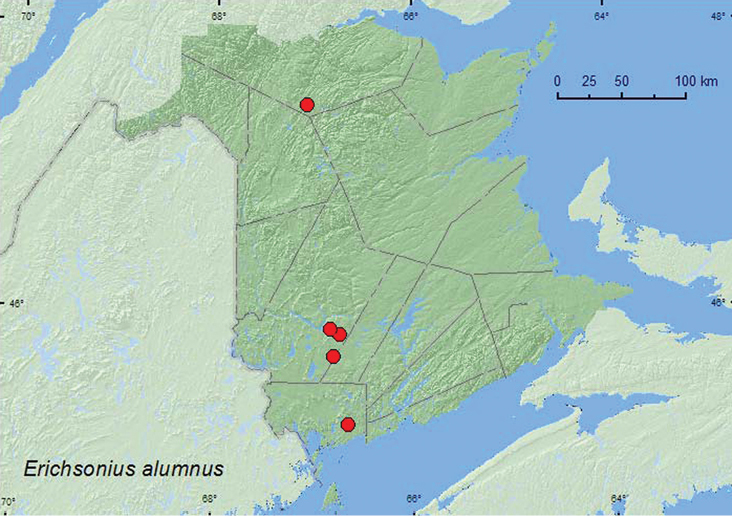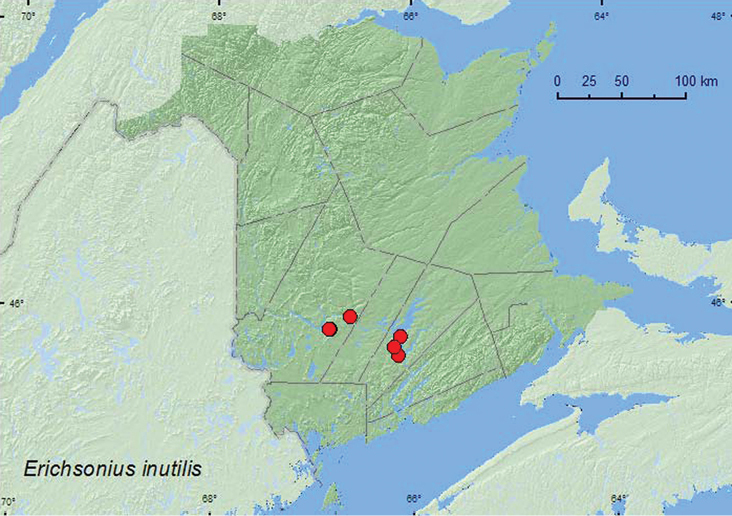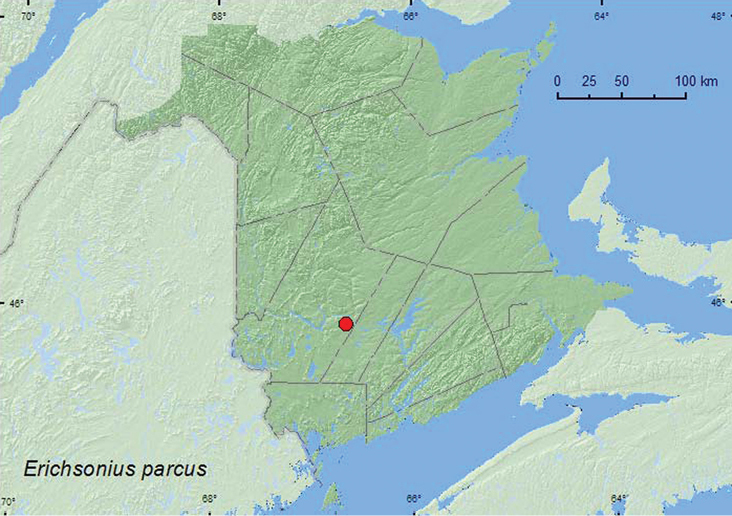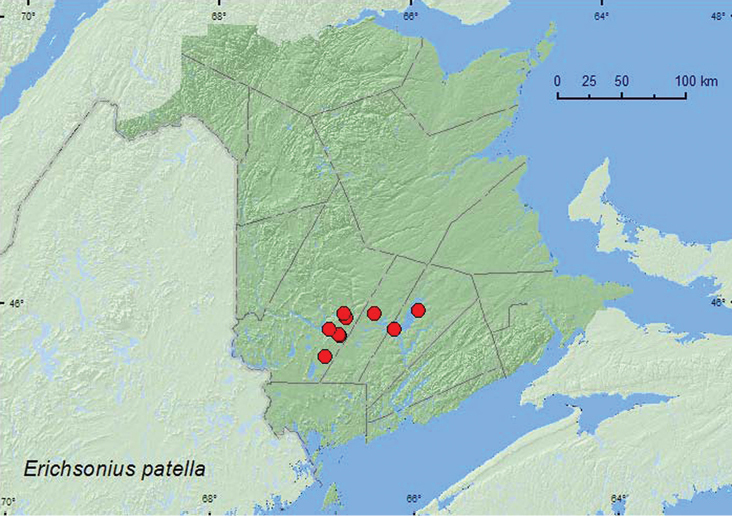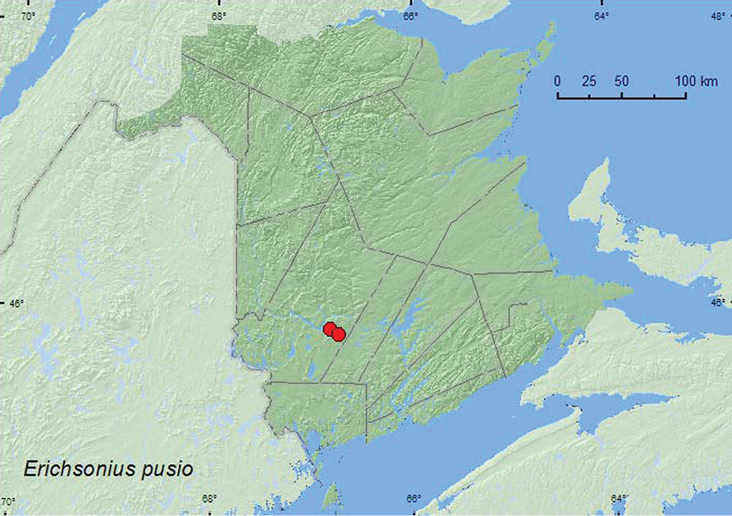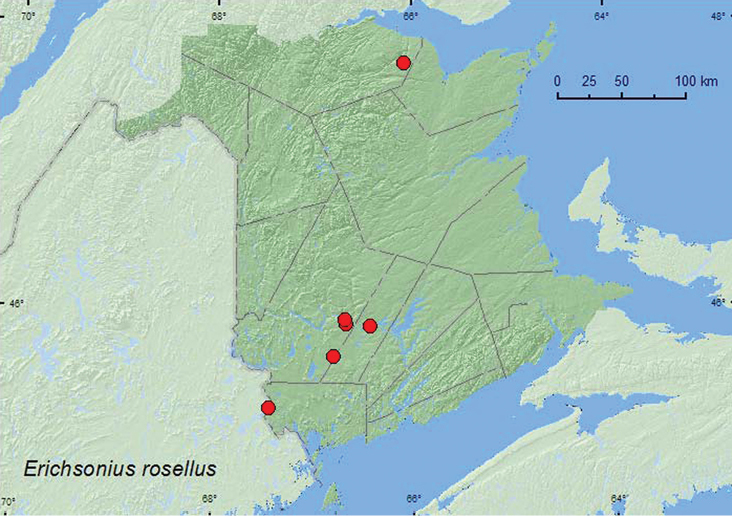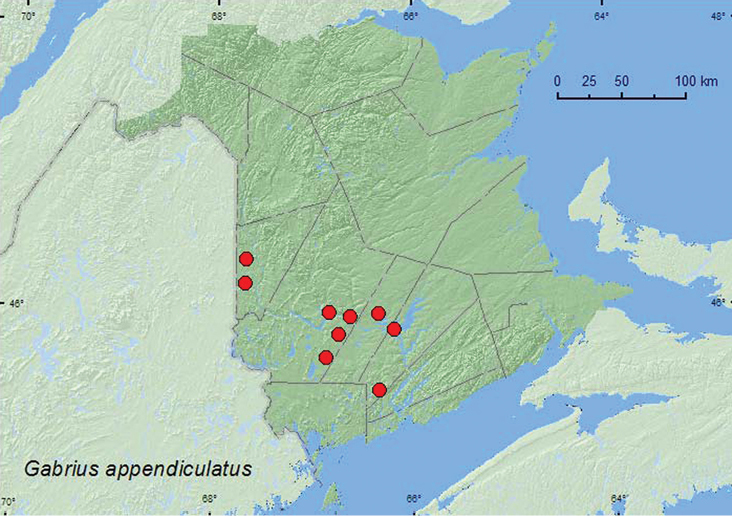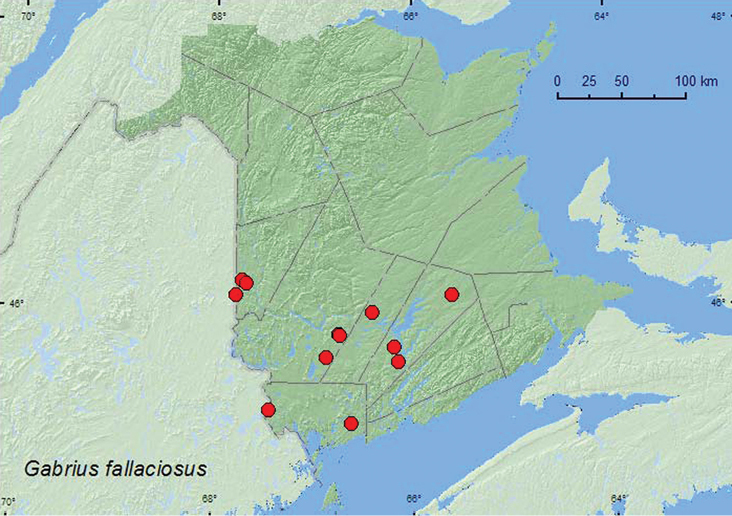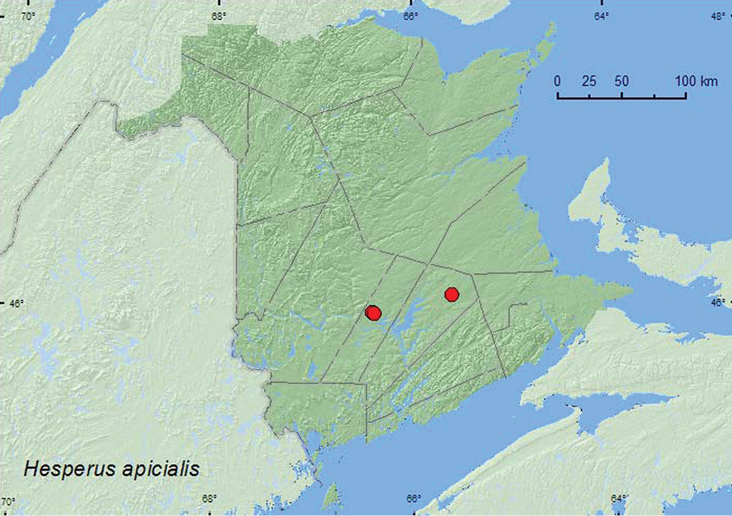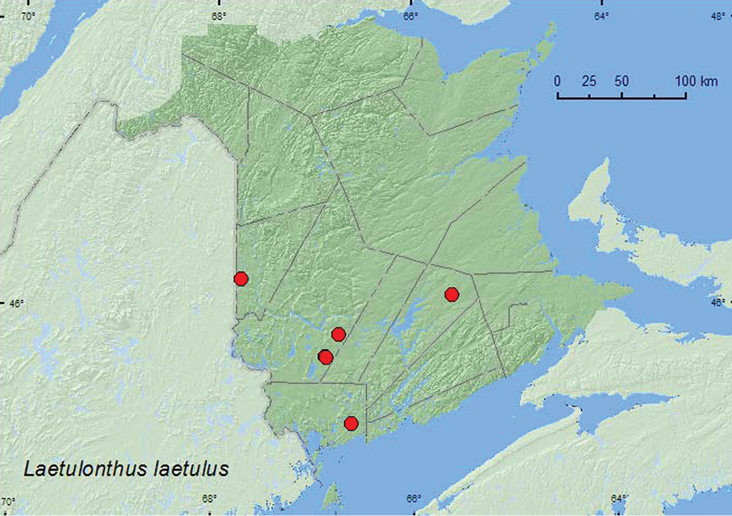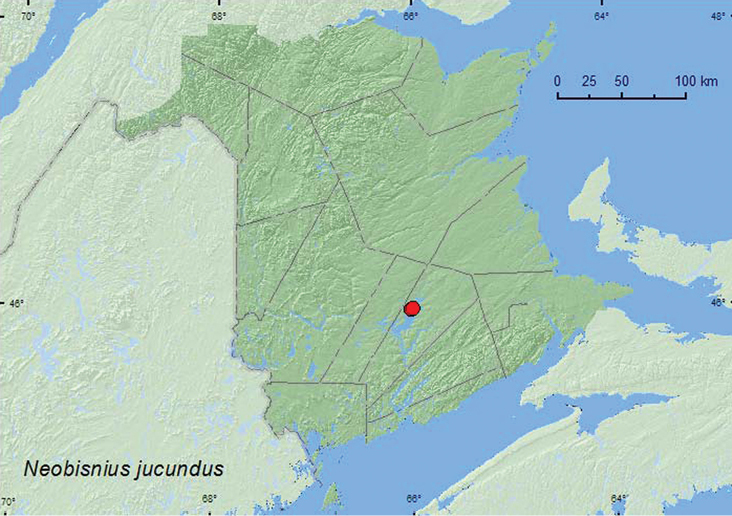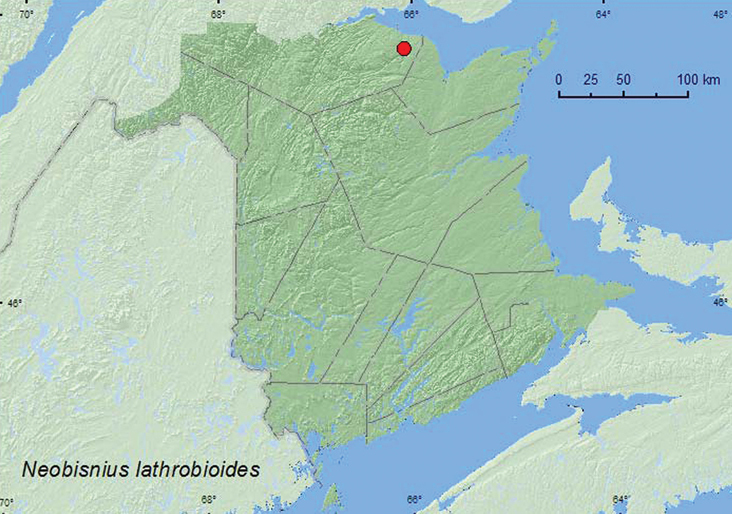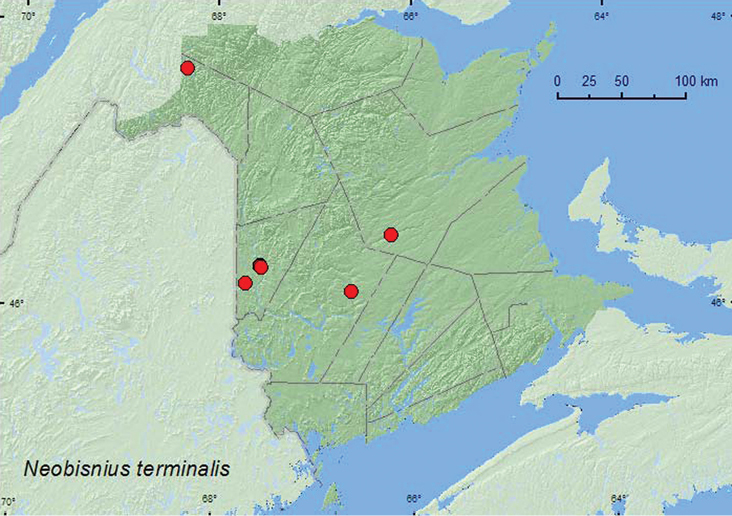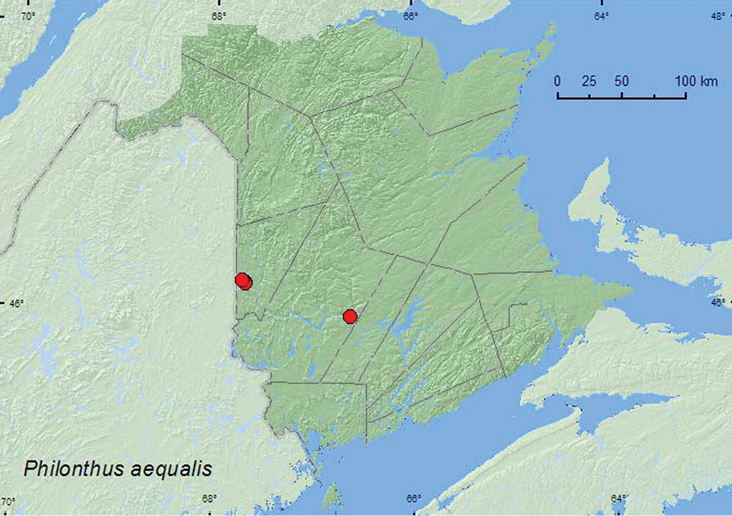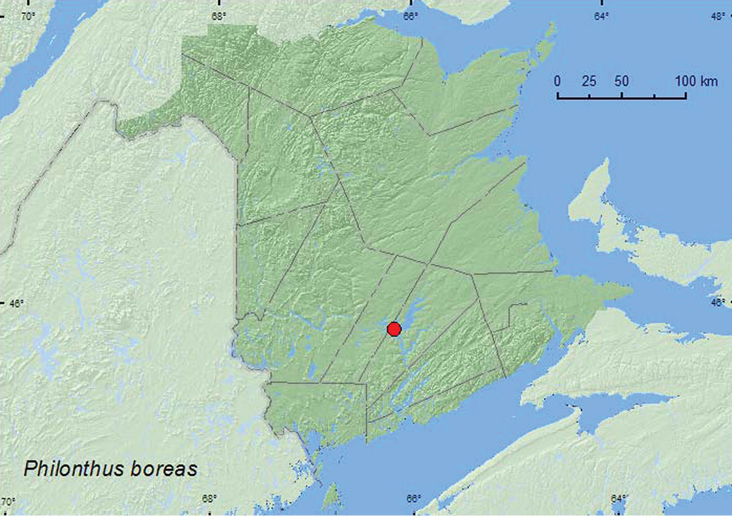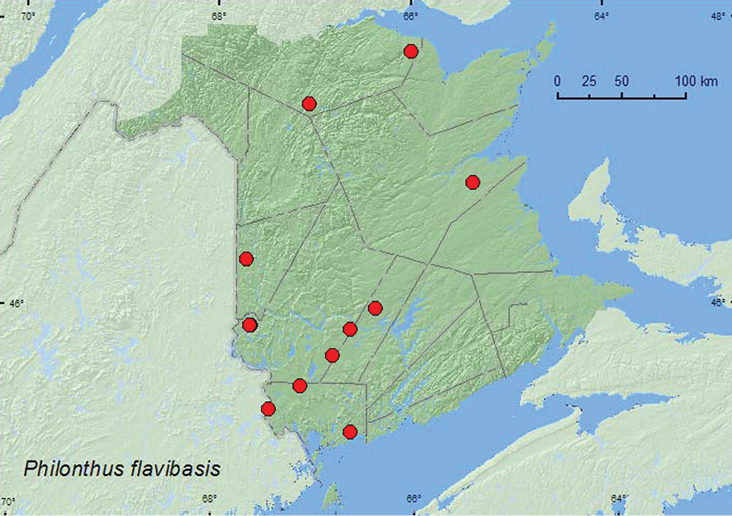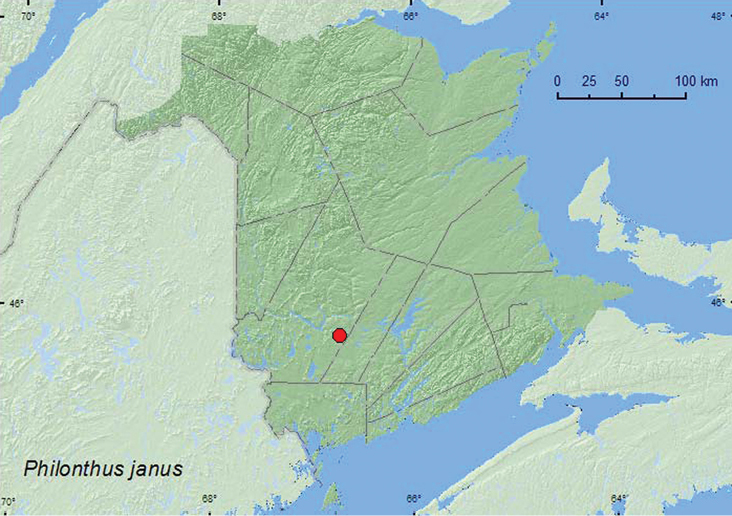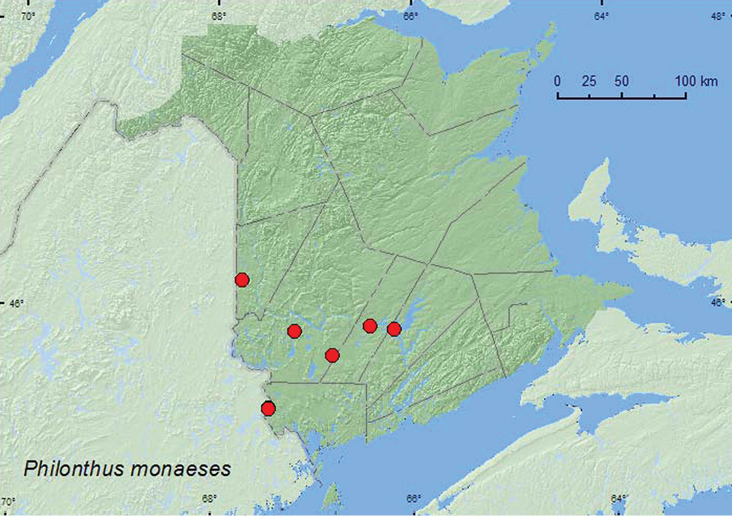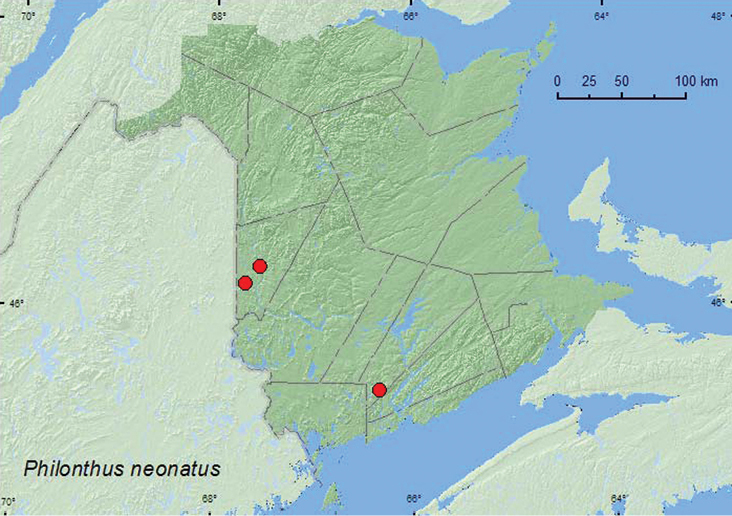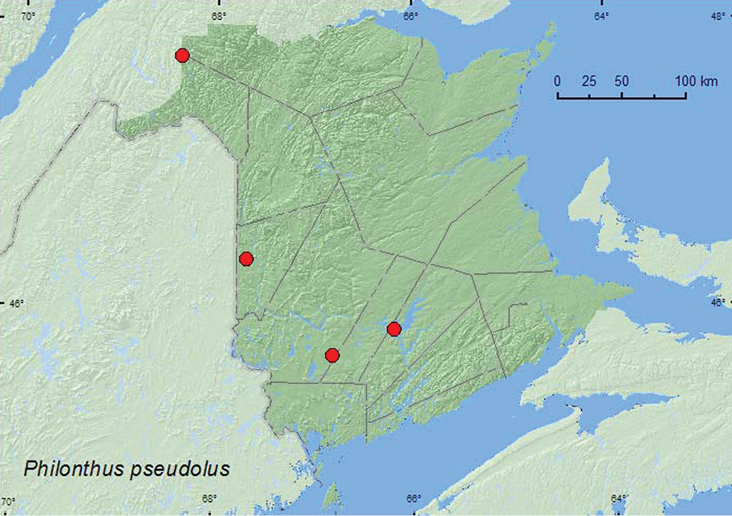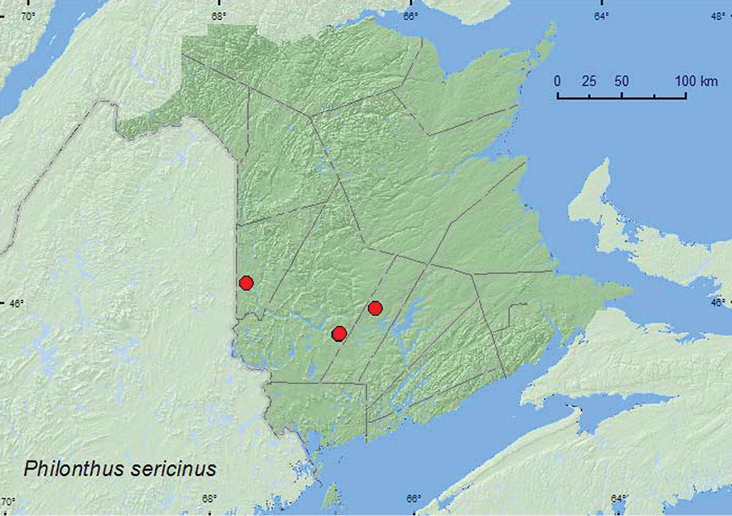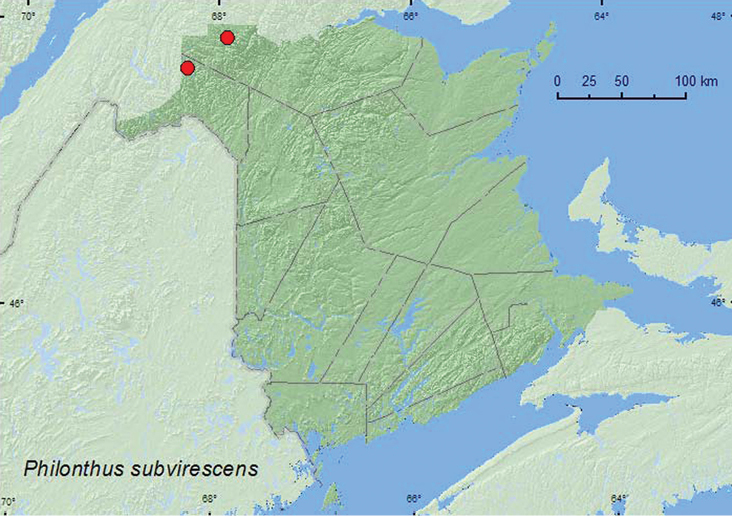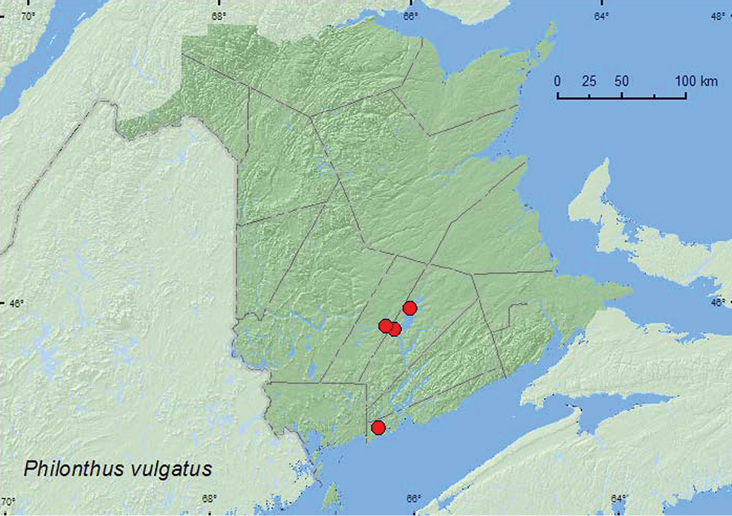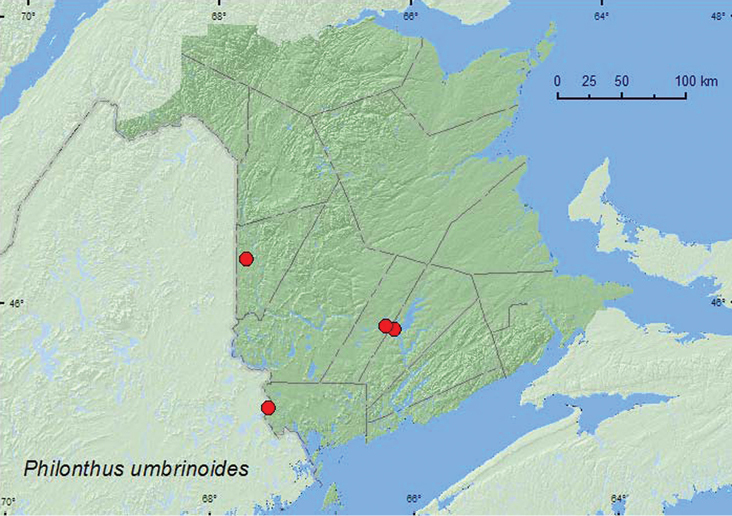






(C) 2012 Reginald P. Webster. This is an open access article distributed under the terms of the Creative Commons Attribution License 3.0 (CC-BY), which permits unrestricted use, distribution, and reproduction in any medium, provided the original author and source are credited.
For reference, use of the paginated PDF or printed version of this article is recommended.
Forty-four species of Staphylininae are newly reported from New Brunswick, bringing the total number of species known from the province to 126. Quedius criddlei (Casey) is reported for the first time from Quebec. Bisnius cephalotes (Gravenhorst) is removed from the faunal list of New Brunswick due to a lack of supporting voucher specimens. Additional locality data are presented for seven species either recently recorded from the province or with few previous records and little habitat data. We provide the first documented records of Atrecus americanus (Casey), Quedius erythrogaster Mannerheim, Quedius labradorensis labradorensis Smetana, Quedius plagiatus (Mannerheim), and Neobisnius terminalis (LeConte) from New Brunswick. Collection and habitat data are presented and discussed for all species.
Staphylinidae, Staphylininae, new records, Canada, New Brunswick, United States, Maine
Intensive collecting of rove beetles (family Staphylinidae) in New Brunswick by the first author since 2003 has yielded many new provincial and national records. Additional records were obtained from by-catch samples during a study to develop a general attractant for detecting invasive species of Cerambycidae. These records are being published in a series of papers, each focusing on one or more subfamilies of Staphylinidae and other families of Coleoptera. This paper covers the subfamily Staphylininae.
This subfamily is fairly well known taxonomically in Canada and North America, thanks to various revisions. The genera Erichsonius and Neobisnius were revised by
Adults of Staphylininae live in a wide variety of habitats. Many species live in and near wetlands, including river and brook margins, lakeshores, vernal pool and pond margins, bogs, marshes, sea beaches, and various synanthropic situations (
Species of Staphylininae (Staphylinidae) recorded from New Brunswick, Canada.
| Subfamily Staphylininae Latreille |
| Tribe Diochini Casey |
| Diochus schaumi Kraatz** |
| Tribe Othiini Thomson |
| Atrecus americanus (Casey) |
| Atrecus macrocephalus (Nordmann) |
| Tribe Xantholinini Erichson |
| Gyrohypnus angustatus Stephens |
| Gyrohypnus campbelli Smetana* |
| Gyrohypnus fracticornis (Müller) |
| Hypnogyra gularis (LeConte)** |
| Leptacinus intermedius Donisthorpe |
| Neohypnus beckeri Smetana** |
| Neohypnus hamatus (Say) |
| Neohypnus obscurus (Erichson) |
| Nudobius cephalus (Say) |
| Oxybleptes kiteleyi Smetana |
| Phacophallus parumpunctatus (Gyllenhal)** |
| Stictolinus flavipes (LeConte) |
| Xantholinus linearis (Olivier) |
| Xestolinus abdominalis Casey** |
| Tribe Staphylinini Latreille |
| Subtribe Quediina Kraatz |
| Acylophorus (Amacylophorus) pratensis LeConte** |
| Acylophorus (Acylophorus) caseyi Leng* |
| Acylophorus (Acylophorus) pronus Erichson |
| Anaquedius vernix (LeConte) |
| Hemiquedius ferox (LeConte)* |
| Heterothops fusculus LeConte |
| Heterothops minor Smetana* |
| Heterothops pusio LeConte** |
| Quedius (Microsaurus) bicoloris Smetana & Webster |
| Quedius (Microsaurus) campbelli Smetana** |
| Quedius (Microsaurus) canadensis (Casey) |
| Quedius (Microsaurus) criddlei (Casey)** |
| Quedius (Microsaurus) erythrogaster Mannerheim |
| Quedius (Microsaurus) mesomelinus (Marsham) |
| Quedius (Microsaurus) peregrinus (Gravenhorst) |
| Quedius (Microsaurus) spelaeus Horn |
| Quedius (Quedius) curtipennis Bernhauer |
| Quedius (Quedius) labradorensis Smetana |
| Quedius (Quedionuchus) plagiatus (Mannerheim) |
| Quedius (Distichalius) capucinus (Gravenhorst)* |
| Quedius (Distichalius) cinctus (Paykull) |
| Quedius (Raphirus) frigidus Smetana** |
| Quedius (Raphirus) fulvicollis (Stephens)** |
| Quedius (Raphirus) rusticus Smetana |
| Quedius (Raphirus) simulator Smetana** |
| Subtribe Staphylinina Latreille |
| Creophilus maxillosus (Linnaeus) |
| Dinothenarus badipes LeConte |
| Dinothenarus capitatus (Bland) |
| Ontholestes cingulatus (Gravenhorst) |
| Platydracus cinnamopterus Gravenhorst |
| Platydracus cupripennis (Melsheimer) |
| Platydracus fossator (Gravenhorst) |
| Platydracus viridanus (Horn) |
| Staphylinus ornaticauda LeConte* |
| Tasgius ater (Gravenhorst) |
| Tasgius melanarius (Heer) |
| Subtribe Xanthopygina Sharp |
| Tympanophorus puncticollis Erichson |
| Subtribe Philonthina Kirby |
| Bisnius blandus (Gravenhorst) |
| Bisnius cephalicus (Casey)** |
| Bisnius palmi (Smetana)* |
| Bisnius quediinus (Horn)** |
| Bisnius siegwaldii (Mannerhiem) |
| Bisnius sordidus (Gravenhorst) |
| Cafius bistriatus Erichson |
| Erichsonius alumnus Frank** |
| Erichsonius inutilis (Horn)** |
| Erichsonius nanus (Horn) |
| Erichsonius parcus (Horn)** |
| Erichsonius patella (Horn)* |
| Erichsonius pusio (Horn)** |
| Erichsonius rosellus Frank** |
| Gabrius appendiculatus Sharp |
| Gabrius astutoides (A. Strand) |
| Gabrius brevipennis (Horn) |
| Gabrius fallaciosus (Horn)** |
| Gabrius microphthalmus (Horn) |
| Gabrius picipennis (Mäklin) |
| Gabrius ulpius Smetana* |
| Hesperus apicialis Say** |
| Laetulonthus laetulus (Say)** |
| Neobisnius jucundus (Horn)** |
| Neobisnius lathrobioides (Baudi)** |
| Neobisnius sobrinus (Erichson) |
| Neobisnius terminalis (LeConte) |
| Neobisnius villosulus (Stephens) |
| Philonthus aequalis Horn** |
| Philonthus boreas Smetana** |
| Philonthus caeruleipennis (Mannerheim) |
| Philonthus carbonarius (Gravenhorst) |
| Philonthus cognatus Stephens |
| Philonthus concinnus (Gravenhorst) |
| Philonthus couleensis Hatch |
| Philonthus cruentatus (Gmelini) |
| Philonthus debilis (Gravenhorst) |
| Philonthus discoideus (Gravenhorst) |
| Philonthus flavibasis Casey** |
| Philonthus flumineus Casey |
| Philonthus furvus Nordman |
| Philonthus fusiformis Melsheimer |
| Philonthus gracilior Casey |
| Philonthus hepaticus Erichson |
| Philonthus hudsonicus Horn |
| Philonthus janus Smetana |
| Philonthus jurgans Tottenham |
| Philonthus lindrothi Smetana |
| Philonthus lomatus Erichson |
| Philonthus monaeses Smetana |
| Philonthus neonatus Smetana* |
| Philonthus opacipennis Notman |
| Philonthus palliatus (Gravenhorst) |
| Philonthus politus (Linnaeus) |
| Philonthus pseudolus Smetana** |
| Philonthus quadricollis Horn |
| Philonthus rectangulus Sharp |
| Philonthus schwarzi Horn |
| Philonthus sericans (Gravenhorst) |
| Philonthus sericinus Horn** |
| Philonthus sessor Smetana |
| Philonthus sphagnorum Smetana |
| Philonthus spiniformis Hatch |
| Philonthus stictus Hausen |
| Philonthus subvirescens Thomson |
| Philonthus thoracicus (Gravenhorst) |
| Philonthus umbratilis (Gravenhorst) |
| Philonthus umbrinoides Smetana* |
| Philonthus validus Casey |
| Philonthus varians (Paykull) |
| Philonthus varro Smetana |
| Philonthus vulgatus Casey* |
Notes: *New to province; **New to Maritime provinces
The following records are based in part on specimens collected as part of a general survey by the first author to document the Coleoptera fauna of New Brunswick. Additional provincial records were obtained from specimens contained in the collection at Natural Resources Canada’s Atlantic Forestry Centre in Fredericton, New Brunswick.
Collection methodsVarious collection methods were employed to collect the Staphylininae reported in this study. Details are outlined in
Examples of most species of Staphylininae were dissected to confirm their identity. The genital structures were dehydrated in absolute alcohol, mounted in Canada balsam on celluloid microslides, and pinned with the specimens from which they originated.
DistributionDistribution maps, created using ArcMap and ArcGIS, are presented for each species in New Brunswick. Every species is cited with current distribution in Canada and Alaska, using abbreviations for the state, provinces, and territories. New records for New Brunswick are indicated in bold under Distribution in Canada and Alaska. The following abbreviations are used in the text:
| AK | Alaska | MB | Manitoba |
| YT | Yukon Territory | ON | Ontario |
| NT | Northwest Territories | QC | Quebec |
| NU | Nunavut | NB | New Brunswick |
| BC | British Columbia | PE | Prince Edward Island |
| AB | Alberta | NS | Nova Scotia |
| SK | Saskatchewan | NF & LB | Newfoundland and Labrador* |
Acronyms of collections referred to in this study are as follows:
AFC Atlantic Forestry Centre, Natural Resources Canada, Canadian Forest Service, Fredericton, New Brunswick, Canada
CNC Canadian National Collection of Insects, Arachnids and Nematodes, Agriculture and Agri-Food Canada, Ottawa, Ontario, Canada
CCC C. Chantal Collection, Varennes, Quebec, Canada
NBM New Brunswick Museum, Saint John, New Brunswick, Canada
RWC Reginald Webster Collection, Charters Settlement, New Brunswick, Canada
ResultsForty-four species of Staphylininae are newly recorded from New Brunswick; Bisnius cephalotes (Gravenhorst) is removed from the faunal list of New Brunswick because of lack of a supporting voucher specimen. We provide the first documented records of Atrecus americanus (Casey), Quedius erythrogaster Mannerheim, Quedius labradorensis labradorensis Smetana, Quedius plagiatus (Mannerheim), and Neobisnius terminalis (LeConte) from New Brunswick. This brings the total number of species known from the province to 126 (Table 1). Thirty-three of these species are newly recorded for the Maritime provinces (New Brunswick, Nova Scotia, Prince Edward Island) of Canada. Additional locality data are presented for seven species either recently recorded from the province or having few previous records and little bionomic data. Quedius criddlei (Casey) is reported for the first time from Quebec.
Species accountsAll records below are species newly recorded for New Brunswick, Canada, unless noted otherwise (additional records). Species followed by ** are newly recorded from the Maritime provinces of Canada.
The classification of the Staphylininae follows
New Brunswick, York Co., Upper Brockway, 45.5684°N, 67.0993°W, 23.IV.2006, R. P. Webster, forested black spruce bog, in sphagnum. (1, RWC)
The single New Brunswick specimen was collected from sphagnum in a forested black spruce (Picea mariana (Mill.) B.S.P.) bog. Elsewhere this species has been reported from forest litter and from wet moss and debris in wet habitats, such as swamps, marshes, bogs, and lake and stream margins (
Additional New Brunswick records, Albert Co., Caledonia Gorge P.N.A. (Protected Natural Area), at Turtle Creek, 45.8432°N, 64.8411°W, 5.VII.2011, A. Fairweather, old hardwood forest (sugar maple and beech), in rotten log near creek (1, NBM); Caledonia Gorge P.N.A. at Caledonia Creek, 45.7935°N, 64.7760°W, 1.VII.2011, R. P. Webster, shaded, rocky, cold, clear brook, splashing moss on rocks (1, NBM). Carleton Co., Hovey Hill PNA, (Protected Natural Area), 46.1115°N, 67.7770°W, 19.VIII.2007, R. P. Webster, hardwood forest, under bark. (1, RWC); Jackson Falls, Bell Forest, 46.2208°N, 67.7211°W, 10.VII.2004, Vincent Webster & R. P. Webster, mixed forest, in bracket fungi (1, RWC); same locality and forest type but 46.2200°N, 67.7231°W, 13.VIII.2006, R. P. Webster, in decaying fleshy polypore fungi (1, RWC); same locality and forest type, 8–16.VI.2009, 16–21.VI.2009, 19–31.VII.2009, R. Webster & M.-A. Giguère, Lindgren funnel traps (3, AFC). Queens Co., Cranberry Lake PNA, 46.1125°N, 65.6075°W, 21–27.V.2009, 21–28.VII.2009, 28.VII-6 VIII.2009, R. Webster & M.-A. Giguère, mature red oak forest, Lindgren funnel traps (3, AFC). Restigouche Co., Berry Brook PNA, 47.8140°N, 66.7578°W, 26.V.2007, R .P. Webster, old-growth eastern white cedar swamp, in moss on hummock at base of cedar (2 ♂, RWC); Jacquet River Gorge PNA, 47.7491°N, 66.1114°W, 24.VI.2008, R. P. Webster, hardwood forest, under bark (1, NBM). Sunbury Co., Acadia Research Forest, 45.9799°N, 66.3394°W, 14.V.2007, R. P. Webster, mature red spruce and red maple forest, sifting deep conifer litter at base of large red spruce (1, AFC); Acadia Research Forest, 45.9866°N, 66.3841°W, 2–9.VI.2009, 21–29.VII.2009, 29.VII-4.VIII.2009, R. Webster & M.-A. Giguère, mature (110-year-old) red spruce forest with scattered red maple and balsam fir, Lindgren funnel traps (3, AFC). York Co., Charters Settlement, 45.8300°N, 66.7360°W, 1.V.2004, R. P. Webster, mixed forest, under bark of conifer log (1, RWC); same locality data and collector but 21.VI.2004, mixed forest, under bark (1, RWC); same locality and collector but 45.8286°N, 66.7211°W, 10.VII.2005, mature red spruce and cedar forest, in bracket fungi (1 ♂, RWC); Fredericton, Odell Park, 7.IX.2005, 45.9570°N, 66.6695°W, R. P. Webster, old-growth hemlock forest, on bracket fungi (1, RWC); 15 km W of Tracy off Rt. 645, 45.6848°N, 66.8821°W, 1–8.VI.2009, R. Webster & M.-A. Giguère, old red pine forest, Lindgren funnel trap (1, AFC); 14 km WSW of Tracy, S of Rt. 645, 45.6741°N, 66.8661°W, 10–26.V.2010, R. Webster & C. MacKay, coll., old mixed forest with red and white spruce, red and white pine, balsam fir, eastern white cedar, red maple, and Populus sp., Lindgren funnel trap (1, AFC).
ON, QC, NB, NS (
Collection localities in New Brunswick, Canada of Atrecus americanus.
New Brunswick, Restigouche Co., Jacquet River Gorge P.N.A, 47.7146°N, 66.1644°W, 24.VI.2008, R. P. Webster, alder swamp adjacent to slow flowing brook, in leaves on muddy soil (1 ♂, NBM). York Co., Charters Settlement, 45.8428°N, 66.7279°W, 19.IV.2005, 28.IV.2004, R. P. Webster, mixed forest, in litter near small sedge marsh (2, RWC); same locality but 45.8395°N, 66.7391°W, 23.IV.2004, 29.IV.2004, 9.V.2005, R. P. Webster, mixed forest near small shaded brook, in forest litter (2 ♂, 3 sex undetermined, NBM, RWC); same locality but 45.8341°N, 66.7445°W, 22.IV.2005, R. P. Webster, mature red spruce and eastern white cedar forest, margin vernal pond in leaf litter (2, RWC); New Maryland, off Hwy 2, E of Baker Brook, 45.8760°N, 66.6252°W, 6.IV.2005, R. P. Webster, old growth eastern cedar swamp in moss and litter on hummock (1, RWC); Rt. 645 at Beaver Brook, 45.6860°N, 66.8668°W, R. P. Webster, Carex marsh, in litter at base of dead red maple (1 ♂, RWC); near Mazerolle Settlement, NE of exit 271, off Hwy 2, 45.8776°N, 66.8254°W, 8.VI.2008, R. P. Webster, alder swamp with poplar, in leaf litter and moss near vernal pool (1, NBM).
In New Brunswick, adults were usually found in moss, leaf, and grass litter near various kinds of wet habitats. These included Carex marshes, shaded brook margins, a vernal pond in a mature red spruce and eastern white cedar forest, and on hummocks in an old-growth eastern white cedar swamp. Elsewhere, this species has been found in similar habitats, including a series collected from a beaver lodge (
New Brunswick, Carleton Co., Jackson Falls, Bell Forest, 46.2200°N, 67.7231°W, 18.IX.2006, R. P. Webster, mature hardwood forest, under bark of large dead basswood covered with polypore fungi (1, RWC); same locality and habitat, 20–26.V.2009, R. Webster & M.-A. Giguère, Lindgren funnel trap (1, RWC). Queens Co., Rees, near Grand Lake, 46.0016°N, 65.9466°W, 29.V.2007, S. Makepeace & R. P. Webster, nest box contents of barred owl (1, RWC); Cranberry Lake P.N.A., 46.1125°N, 65.6075°W, 5–12 V.2009, R. Webster & M.-A. Giguère, mature red oak forest, Lindgren funnel trap (1, RWC).
Little is known about the habitat assciations of members of this genus, especially in North America (
New Brunswick, Carleton Co., Jackson Falls, Bell Forest, 46.2200°N, 67.7231°W, 23–28.IV.2009, 20–26.V.2009, R. Webster & M.-A. Giguère, mature hardwood forest, Lindgren funnel traps (3, AFC). Charlotte Co., 10 km NW of New River Beach, 45.2110°N, 66.6170°W, 30.IV-17.V.2010, R. Webster & V. Webster, coll., old growth eastern white cedar forest, Lindgren funnel trap (1, AFC). Queens Co., Cranberry Lake P.N.A., 46.1125°N, 65.6075°W, 12–21.V.2009, 5–11.VI.2009, R. Webster & M.-A. Giguère, mature red oak forest, Lindgren funnel traps (2, AFC). Sunbury Co., Sunpoke Lake, 45.7665°N, 66.5545°W, 15.V.2004, R. P. Webster, red oak and maple forest, under coyote scat and in leaf litter (2, RWC); Acadia Research Forest, 46.0188°N, 66.3765°W, 14.V.2008, 18.VI.2009, R. P. Webster, mature red spruce and red maple forest, sifting leaf litter (2, AFC); Acadia Research Forest, 45.9866°N, 66.3841°W, 13–19.V.2009, 19–25.V.2009, 25.V-2.VI.2009, 2–9.VI.2009, R. Webster & M.-A. Giguère, mature (100-year-old) red spruce forest with scattered red maple and balsam fir, Lindgren funnel traps (6, AFC); ca. 5 km SE of Geary, 45.7057°N, 66.4432°W, 22.V.2009, S. Makepeace & R. Webster, in leaf litter with scat & bones under tree with active great horned owl nest (1, NBM). York Co., Charters Settlement, 45.8304°N, 66.7351°W, 18.IV.2004, 6.V.2004, R. P. Webster, mixed forest, under moist cardboard covering old chicken bones (2, RWC); same locality but 45.8395°N, 66.7391°W, 5.V.2004, 12.V.2004, 9.V.2004, R. P. Webster, mixed forest, in compost (decaying vegetables) (3, RWC); same locality but 45.8286°N, 66.7365°W, 7.VI.2005, R. P. Webster, mature red spruce and eastern white cedar forest, in leaf litter (2 , RWC); Canterbury, “Browns Mountain Fen Complex”, 45.8937°N, 67.6564°W, 8.VI.2004, D. Sabine & R. Webster, black spruce bog with eastern white cedar, in moist sphagnum on bog margin (1, RWC); 14 km WSW of Tracy, S of Rt. 645, 45.6741°N, 66.8661°W, 26.IV-10.V.2010, R. Webster & C. MacKay, coll., old mixed forest with red and white spruce, red and white pine, balsam fir, eastern white cedar, red maple, and Populus sp., Lindgren funnel traps (2, AFC).
In New Brunswick, adults were collected from under coyote scat, under cardboard covering old chicken bones, in compost, in leaf litter in hardwood and mixed forests, and in moist sphagnum on the margin of a black spruce and eastern white cedar bog/fen.
http://species-id.net/wiki/Phacophallus_parumpunctatus
Map 6New Brunswick, York Co., Charters Settlement, 45.8395°N, 66.7391°W, 16.X.2004, R. P. Webster, mixed forest, in compost (decaying vegetables) (1, RWC).
In Europe, this species is synanthropic, occurring in compost, manure, and other decaying organic material (
New Brunswick, Sunbury Co., Acadia Research Forest, 46.0188°N, 66.3765°W, 14.V.2007, R. P. Webster, mixed forest, in flight, collected with net (1 sex undetermined, RWC). York Co., Charters Settlement, 45.8267°N, 66.7343°W, 30.IV.2005, R. P. Webster, Carex marsh, in sphagnum hummock (1 sex undetermined, RWC).
Little is known about the habitat associations of this species. One of the New Brunswick specimens was collected from a sphagnum hummock in a Carex marsh, another was collected while it was flying in a mixed forest near a Carex marsh. Adults were collected in late April and May.
http://species-id.net/wiki/Acylophorus_pratensis
Map 8New Brunswick, Carleton Co., Jackson Falls, Bell Forest, 46.2150°N, 67.7190°W, 12.VI.2008, R. P. Webster, river margin, treading vegetation in seepage area (1, NBM). Charlotte Co., 3.5 km NW of Pomeroy Ridge, 45.3087°N, 67.4362°W, 16.VI.2008, R. P. Webster, red maple swamp, in leaves and moss near small vernal pool (1, NBM). Northumberland Co., Goodfellow Brook P.N.A., 46.8943°N, 65.3796°W, 23.V.2007, R. P. Webster, old growth eastern white cedar swamp, in grass litter and moss on hummocks near pool (1 ♂, 1 sex undetermined, NBM, RWC). Restigouche Co., Jacquet River Gorge P.N.A. at Jacquet River, 47.7765°N, 66.1277°W, 13.VIII.2010, R. P. Webster, in moss on rocks in middle of river, splashing rocks (1, NBM). York Co., Charters Settlement, 45.8395°N, 66.7391°W, 23.IV.2004, 3.VI.2004, 9.V.2005, 6.X.2005, R. P. Webster, mixed forest, in litter and moss near margin of small shaded brook (5, RWC); same locality and collector but 45.8283°N, 66.7350°W, 8.V.2004, sedge marsh, in sphagnum hummock (1, RWC); same locality and collector but 45.8428°N, 66.7279°W, 23.VI.2004, 20.IV.2005, mixed forest, (shaded) margin of small sedge marsh in moist sphagnum (2, RWC); 8.4 km W of Tracy off Rt. 645, 45.6821°N, 66.7894°W, 14.V.2008, R. P. Webster, wet alder swamp, in grass hummock (1, RWC).
In New Brunswick, most adults were collected in red maple (Acer rubrum L.) swamps, alder (Alnus sp.) swamps, and eastern white cedar swamps, usually along vernal pool and brook margins, and in Carex marshes. One adult was collected from a seepage area along a river margin. Adults were sifted from moss and various kinds of grass and leaf litter. Elsewhere, specimens were collected from dead swamp grass and moss (
New Brunswick, Charlotte Co., Rt. 3 at Deadwater Brook, 45.4744°N, 67.1225°W, 3.VI.2005, R. P. Webster, forested black spruce bog, marshy stream margin, treading (1, RWC); near New River, 45.1616°N, 66.6649°W, 7.VII.2006, R. P. Webster, treading sedge marsh (1, NBM); near Clark Ridge, 45.3155°N, 67.4406°W, 27.V.2007, R. P. Webster, beaver pond, treading vegetation (1, NBM). Queens Co., Upper Gagetown, bog adjacent to Hwy 2, 45.8316°N, 66.2346°W, R. P. Webster, tamarack bog, in sphagnum hummock and litter at bog margin (1 ♂, 2 sex undetermined, NBM, RWC). York Co., Charters Settlement, 45.8267°N, 66.7343°W, 8.V.2004, 16.IV.2005, 30.IV.2005, 14.V.2005, R. P. Webster, Carex marsh in sphagnum hummocks (5, RWC).
Penobscot Co., T6 R8 WELS, Marble Fen, 46.1245°N, 68.6983°W, 13.VI.2003, P. deMaynadier and R. Webster, open wet tamarack bog, in moist sphagnum (treading) (1, NBM).
ON, QC, NB, NS (
Collection localities in New Brunswick, Canada and Maine, United States of America of Acylophorus caseyi.
New Brunswick, Carleton Co., Jackson Falls, 46.2257°N, 67.7420°W, 22.V.2010, R. P. Webster, river margin, in gravel near water on gravel bar (1, NBM). Charlotte Co., 3.0 km NW of Pomeroy Ridge, 45.3059°N, 67.4343°W, 5.VI.2008, R. P. Webster, alder swamp, in moss hummocks with grasses (2, NBM, RWC); near New River, 45.2118°N, 66.6179°W, 7.VII.2008, R. P. Webster, mixed forest, margin of small pond, treading Carex hummock (1, RWC). Queens Co., Grand Lake Meadows P.N.A., 45.8227°N, 66.1209°W, 24.VIII-3.IX.2010, C. Hughes & K. Burgess, old silver maple forest with green ash and seasonally flooded marsh, Lindgren funnel trap (1, AFC). Sunbury Co., Maugerville, Portobello Creek N.W.A., 45.8992°N, 66.4248°W, 27.V.2004, 5.VI.2004, R. P. Webster, silver maple swamp, margin of small vernal pond in leaf litter (2, RWC); near Sunpoke Lake, 45.7662°N, 66.5526°W, 20.VI.2007, R. P. Webster, seasonally flooded marsh, treading (1 sex undetermined, RWC). York Co., Fredericton, University of New Brunswick Woodlot, 45.9391°N, 66.6747°W, 17.VIII.2009, R. Webster, D. McAlpine, & G. Forbes, within wall of a beaver (Castor canadensis) lodge (4 ♀, RWC).
Hemiquedius feroxwas reported by
ON, QC, NB, NS (
Collection localities in New Brunswick, Canada of Hemiquedius ferox.
New Brunswick, York Co., Upper Brockway, 45.5684°N, 67.0993°W, 23.IV.2006, R. P. Webster, forested black spruce bog, in sphagnum (1, RWC).
Little is known about the habitat associations of this species.
New Brunswick, Carleton Co., Jackson Falls, Bell Forest, 46.2152°N, 67.7190°W, 1.VI.2005, M.-A. Giguère & R. Webster, river margin, flying adults collected with aerial net between 16:00 and 18:00 h (1 ♂, 1 ♀, RWC). Restigouche Co., Jacquet River Gorge P.N.A., 47.8197°N, 66.0835°W, 23.VI.2008, R. P. Webster, river margin, among cobblestones (1, NBM). York Co., Charters Settlement, 45.8395°N, 66.7391°W, 10.VI.2006, R. P. Webster, mixed forest, m.v. light (3, RWC); same locality data, collector, and forest type, 26.V.2008, compost (decaying vegetables) (1, RWC).
New Brunswick, Restigouche, Co., Dionne Brook P.N.A., 47.9064°N, 68.3441°W, 31.V-15.VI.2011, M. Roy & V. Webster, old-growth white spruce and balsam fir forest, Lindgren funnel trap (1 ♀, RWC). York Co., Fredericton, University of New Brunswick Woodlot, 45.9391°N, 66.6747°W, 17.VIII.2009, R. P. Webster, D. McAlpine, & G. Forbes, in beaver (Castor canadensis) lodge, within wall of lodge (2 ♂, NBM, RWC).
Additional New Brunswick records. Carleton Co., Jackson Falls, Bell Forest, 46.2200°N, 67.7231°W, 18.IX.2006, R. P. Webster, mature hardwood forest, under bark of large, dead, standing basswood covered with bracket fungi (1 ♂, RWC); same locality, 4–12.VI.2008, 12–19.VI.2008, 5–12.VII.2008, 23–28.IV.2009, 9–14.V.2009, 14–20.V.2009, 9–16.VI.2009, R. Webster & M.-A. Giguère, mature hardwood forest, Lindgren funnel traps (2 ♂, 3 ♀, 6 sex undetermined, AFC, NBM, RWC). Charlotte Co., 10 km NW of New River Beach, 45.2110°N, 66.6170°W, 30.IV-17.V.2010, R. P. Webster & V. Webster, coll., old-growth eastern white cedar forest, Lindgren funnel trap (1, AFC). Queens Co., Cranberry Lake P.N.A., 46.1125°N, 65.6075°W, 24.IV-5 V.2009, R. Webster & M.-A. Giguère, mature red oak forest, Lindgren funnel traps (5, AFC, NBM). Restigouche Co., Jacquet River Gorge P.N.A., 47.8160°N, 66.0083°W, 14.VIII.2010, R. P. Webster, old eastern white cedar forest, in polypore fungi on Populus log (1, NBM); Dionne Brook P.N.A., 47.9030°N, 68.3503°W, 28.VII-9.VIII.2011, 9–23.VIII.2011, M. Roy & V. Webster, old-growth northern hardwood forest, Lindgren funnel trap (2, NBM); same locality and collectors but 47.9064°N, 68.3441°W, 27.VI-14.VII.2011, 9–23.VIII.2011, old-growth white spruce and balsam fir forest, Lindgren funnel traps (2, AFC, NBM). Sunbury Co., Acadia Research Forest, 45.9866°N, 66.3841°W, 28.IV-8.V.2009, 8–13.V.2009, 13–19.V.2009, 2–9.VI.2009, 29.VII-4.VIII.2009, R. Webster & M.-A. Giguère, mature (110 year-old) red spruce forest with scattered red maple and balsam fir, Lindgren funnel traps (1 ♂, 13 sex undetermined, AFC, RWC). York Co., Charters Settlement, 45.8395°N, 66.7391°W, 25–29.IV.2008, R. P. Webster, mixed forest, Lindgren funnel trap (1 ♂, RWC); 15 km W of Tracy, off Rt. 645, 45.6848°N, 66.8821°W, 25.IV-4V.2009, 4–11.V.2009, 11–19.V.2009, R. Webster & M.-A. Giguère, mature (120–180 year-old) red pine forest, Lindgren funnel traps (3 ♂, 4 sex undetermined, AFC, RWC); 14 km WSW of Tracy, S of Rt. 645, 45.6741°N, 66.8661°W, 26.IV-10.V.2010, R. Webster & C. MacKay, coll., old mixed forest with red and white spruce, red and white pine, balsam fir, eastern white cedar, red maple, and Populus sp., Lindgren funnel traps (2, AFC).
Little is known about the habitat associations of this species.
ON, QC, NB, NS (
Collection localities in New Brunswick, Canada of Quedius canadensis.
New Brunswick, Queens Co., Cranberry Lake P.N.A., 46.1125°N, 65.6075°W, 7–13.VII.2011, 20.VII-4.VIII.2011, M. Roy & V. Webster, old red oak forest, Lindgren funnel trap (2 ♀, NBM, RWC). Restigouche Co., Dionne Brook P.N.A., 47.9030°N, 68.3503°W, 27.VI-14.VII.2011, 9–23.VIII.2011, M. Roy & V. Webster, old-growth northern hardwood forest, Lindgren funnel traps (2 ♂, 2 ♀, NBM, RWC); same locality and collectors but 47.9064°N, 68.3441°W, 31.V-15.VI.2011, 15–27.VI.2011, 27.VI-14.VII.2011, 14–28.VII.2011, 9–23.VIII.2011, old-growth white spruce and balsam fir forest, Lindgren funnel traps (3 ♂, 6 ♀, AFC, NBM, RWC). York Co., 15 km W of Tracy off Rt. 645, 45.6848°N, 66.8821°W, 1–8.VI.2009, R. Webster & M.-A. Giguère, old red pine forest, Lindgren funnel trap (1 ♀, RWC); same locality and habitat data, 4–16.VI.2010, R. Webster & C. MacKay, Lindgren funnel traps (1 ♂, RWC). Quebec, Saguenay Co. Sept-Iles, 20.V.1985, 13.IX.1985, C. Chantal (1♂, 1 ♀, CCC).
Little is known about the habitat associations of this species. Adults have been taken from leaf litter in Larix forests, in rotten Douglas-fir (Pseudotsuga taxifolia Britton) and grand fir (Abies grandis (Douglas ex. D. Don) Lindl.) logs, under board in a meadow, ex fungus, and in association with the ant Formica neorufibarbis Emery (probably accidentally) (
NT, YT, BC, AB, MB, ON, QC, NB (
Collection localities in New Brunswick, Canada of Quedius erythrogaster.
http://species-id.net/wiki/Quedius_erythrogaster
Map 16Additional New Brunswick records, Carleton Co., Jackson Falls, Bell Forest, 46.2208°N, 67.7211°W, 10.IV.2005, R. P. Webster, mature hardwood forest, in leaf litter at base of tree (1 ♂, RWC). Queens Co., Cranberry Lake P.N.A., 46.1125°N, 65.6075°W, 24.IV–5 V.2009, 5–12 V.2009, R. Webster & M.-A. Giguère, mature red oak forest, Lindgren funnel traps (2, AFC). Restigouche Co., Dionne Brook P.N.A., 47.9030°N, 68.3503°W, 27.VI–14.VII.2011, M. Roy & V. Webster, old-growth northern hardwood forest, Lindgren funnel traps (1 ♂, 2 ♀, NBM, RWC). Sunbury Co., Noonan, 45.9923°N, 66.4099°W, 22.VI.2007, S. Makepeace & R. Webster, mature mixed forest, in nest contents of barred owl, 7 m high in cavity in a red maple (1 ♂, 1 ♀, RWC); Acadia Research Forest, 45.9866°N, 66.3841°W, 22–25.IV.2009, 25.IV-4.V.2009, 4–11.V.2009, 19–25.V.2009, R. Webster & M.-A. Giguère, mature (110-year-old) red spruce forest with scattered red maple and balsam fir, Lindgren funnel traps (4, AFC). York Co., Charters Settlement, 45.8395°N, 66.7391°W, 18.IV.2004, 30.IV.2004, 5.V.2006, 9.V.2006, R. P. Webster, mixed forest, in compost (decaying vegetables) (2 ♂, 2 ♀, RWC); same locality but 45.8430°N, 66.7275°W, 6.X.2005, R. P. Webster, regenerating mixed forest, baited with pile of decaying mushrooms (2 ♂, RWC); 15 km W of Tracy off Rt. 645, 45.6848°N, 66.8821°W, 22–25.IV.2009, 25.IV–4.V.2009, 4–11.V.2009, 19–25.V.2009, R. Webster & M.-A. Giguère, Lindgren funnel traps (4, AFC).
Quedius erythrogastertypically lives in nests and burrows of various mammals and in caves but has been found in decaying organic matter and debris (
BC, AB, SK, ON, QC, NB (
Collection localities in New Brunswick and Quebec, Canada of Quedius criddlei.
http://species-id.net/wiki/Quedius_mesomelinus
Map 17Additional New Brunswick records, Carleton Co., Jackson Falls, Bell Forest, 46.2200°N, 67.7231°W, 18.IX.2006, 9.X.2006, R. P. Webster, mature hardwood forest, under bark of large dead standing basswood covered with bracket fungi (1 ♂, 1 ♀, RWC); same locality, 4–12.VI.2008, 12–19.VI.2008, 19–27.VI.2008, 5–12.VII.2008, 12–19.VII.2008, 19–28.VII.2008, R. P. Webster, mature hardwood forest, Lindgren funnel traps (2 ♂, 4 ♀, 7 sex undetermined, AFC, RWC); same locality, 14–20.V.2009, 16–21.VI.2009 , R. Webster & M.-A. Giguère, mature hardwood forest, Lindgren funnel traps (2, AFC). Restigouche, Co., Dionne Brook P.N.A., 47.9064°N, 68.3441°W, 27.VI-14.VII.2011, M. Roy & V. Webster, old-growth white spruce and balsam fir forest, Lindgren funnel trap (1, NBM). York Co., Odell Park, 45.9570°N, 66.6695°W, 19.VI.2005, R. P. Webster, moist wood chips and decaying plant material (1 ♀, RWC).
In Europe, this species is typically found in synanthropic situations in decaying organic materials such as compost (
AK, BC, AB, MB, ON, QC, NB, NS, NF (
Collection localities in New Brunswick, Canada of Quedius mesomelinus.
http://species-id.net/wiki/Quedius_peregrinus
Map 18Additional New Brunswick records. Albert Co., Caledonia Gorge P.N.A., 45.8257°N, 64.7791°W, 6.VII.2011, R. P. Webster, old hardwood forest (sugar maple and beech), in decayed fleshy polypore in log (1 ♂, NBM). Sunbury Co., Maugerville, Portobello Creek N.W.A., 45.9031°N, 66.4268°W, 11.IX.2006, R. P. Webster, red oak and red maple forest, on gilled mushroom (1 ♀, RWC); Acadia Research Forest, pitfall trap (collection) dates, 17.VIII.1999, 24.VIII.1999, 25.VIII.1999, 8.IX.1999, 13.IX.1999, 15.IX.1999, G. Gesner, strip, select., and control plots (15, AFC); same locality but 46.0188°N, 66.3765°W, 17.VIII.2007, R. P. Webster, mature red spruce and red maple forest, sifting moss (1, AFC); same locality and collector but 46.0173°N, 66.3741°W, 18.IX.2007, 8.5 year-old regenerating mixed forest, in sphagnum and leaf litter at bottom of old tire depression (1, AFC). York Co., Charters Settlement, 45.8395°N, 66.7391°W, 18.VII.2006, R. P. Webster, mixed forest, on rotting fungus covered log (1 ♀, RWC); same locality data, collector, and (adjacent) forest type, 4.X.2005, residential lawn, on soil at base of grasses (1 ♂, RWC); same locality, collector, and adjacent forest type but 45.8348°N, 66.7335°W, 4.VIII.2004, in fleshy fungi (1, NBM); same locality and collector but 45.8430°N, 66.7275°W, 12.VII.2005, regenerating mixed forest, beating foliage (2 ♂, 3 ♀, RWC); same locality data, collector, and forest type, 25.IX.2005, baited with pile of decaying mushrooms (1 ♂, RWC).
One of the Nova Scotia specimens was collected by treading wet Sphagnum (
ON, QC, NB, NS (
Collection localities in New Brunswick, Canada of Quedius peregrinus.
Additional New Brunswick records. Carleton Co., Jackson Falls, Bell Forest, 46.2152°N, 67.7190°W, 21.VIII.2004, 15.IX.2004, R. P. Webster, upper river margin under litter on clay soil (2 ♀, RWC); Hovey Hill P.N.A., 46.1115°N, 67.7770°W, 10.V.2005, R. P. Webster, mature hardwood forest in moist leaf litter and moss on margin of vernal pond (2 ♂, 1♀, RWC). York Co., Pokiok, 2.VI.1995, (G. Gesner) pitfall trap (1♂, AFC); Charters Settlement, 45.8395°N, 66.7391°W, 30.IV.2005, R. P. Webster, mixed forest, in compost (decaying vegetables) (1 ♂, RWC); same locality data, collector, and forest type, 5.IX.2006, in pile of decaying corncobs and cornhusks (1♀, RWC).
This species has been reported mostly from around human settlements in various kinds of debris and under stones (
BC, ON, NB, NS (
Collection localities in New Brunswick, Canada of Quedius curtipennis.
http://species-id.net/wiki/Quedius_labradorensis_labradorensis
Map 20Additional New Brunswick records, Restigouche Co., Little Tobique River near Red Brook, 47.4462°N, 67.0689°W, 24.V.2007, R. P. Webster, coll., old growth eastern white cedar forest, in moss and leaf litter near brook (1 ♂, NBM); MacFarlane Brook P.N.A., 47.6018°N, 67.6263°W, 25.V.2007, R. P. Webster, old growth eastern white cedar swamp, in moss near brook (1 ♂, RWC); Berry Brook P.N.A., 47.8140°N, 66.7578°W, 26.V.2007, R. P. Webster, old growth eastern white cedar swamp, in moss on hummock at base of eastern white cedar (2 ♀, RWC). Saint John Co., Musquash, 45.1696°N, 66.3140°W, 7.V.2006, R. P. Webster, spruce forest, in sphagnum and litter on margin of brook (1 ♂, RWC); ca. 2.0 km NE of Maces Bay, 45.1168°N, 66.4552°W, 8.V.2006, R. P. Webster, eastern white cedar swamp, under deer dung (1 ♂, RWC). York Co., Charters Settlement, 45.8395°N, 66.7391°W, 30.IV.2004, R. P. Webster, mixed forest, m.v. light (1 ♀, RWC).
AK, BC, NT, AB, MB, ON, QC, NB, NF (
Collection localities in New Brunswick, Canada of Quedius l. labradorensis.
http://species-id.net/wiki/Quedius_plagiatus
Map 21Additional New Brunswick records, Albert Co., Caledonia Gorge P.N.A., 45.8257°N, 64.7791°W, 6.VII.2011, R. P. Webster, old hardwood forest (sugar maple and beech), under bark of sugar maple log (1, NBM). Carleton Co., Hovey Hill P.N.A., 46.1115°N, 67.7770°W, 19.VIII.2004, R. P. Webster, hardwood forest, under bark of log (1 ♀, RWC); Jackson Falls, Bell Forest, 46.2200°N, 67.7231°W, 4–12.VI.2008, R. P. Webster, mature hardwood forest, Lindgren funnel trap (1, AFC); same locality, 14–20.V.2009, 16–21.VI.2009 , R. P. Webster & M.-A. Giguère, mature hardwood forest, Lindgren funnel traps (2, AFC). Charlotte Co., 5.1 km NW of Pomeroy Ridge, 45.3055°N, 67.4340°W, 5.VI.2008, R. P. Webster, mixed forest, under bark of spruce log (1, NBM); 10 km NW of New River Beach, 45.2110°N, 66.6170°W, 30.IV-17.V.2010, R. Webster & V. Webster, coll., old growth eastern white cedar forest, Lindgren funnel trap (1, AFC). Queens Co., Cranberry Lake P.N.A., 46.1125°N, 65.6075°W, 24.IV-5 V.2009, 21–27.V.2009, 5–11.VI.2009, 18–25.VI.2009, 25.VI-1 VII.2009, 21–28.VII.2009, 6–14.VIII.2009, R. Webster & M.-A. Giguère, mature red oak forest, Lindgren funnel traps (2 ♀, 13 sex undetermined, AFC, NBM, RWC). Restigouche Co., Little Tobique River near Red Brook, 47.4462°N, 67.0689°W, 24.V.2007, R. P. Webster, old-growth eastern white cedar forest, under bark of large fallen spruce (1 ♀, NBM); Jacquet River Gorge P.N.A., 47.8200°N, 66.0015°W, 13.V.2010, R. P. Webster (1, NBM); same locality but 47.8257°N, 66.0779°W, 14.V.2010, P. Giasson, old mixed forest, under bark of Populus sp. log (1, NBM); South Branch Rd., 494 m elev., 47.8767°N, 68.2657°W, 22.VI.2010, R. P. Webster, Spruce and balsam fir forest, under bark of spruce (1, NBM); Dionne Brook P.N.A., 47.9030°N, 68.3503°W, 28.VII-9.VIII.2011, M. Roy & V. Webster, old-growth northern hardwood forest, Lindgren funnel trap (2, AFC, NBM); same locality and collectors but 47.9064°N, 68.3441°W, 15–27.VI.2011, old-growth white spruce and balsam fir forest, Lindgren funnel traps (2, AFC, NBM). Sunbury Co., Acadia Research Forest, 45.9866°N, 66.3841°W, 6–24.VI.2009, 13–21.VII.2009, 21–29.VII.2009, 29.VII-4.VIII.2009, R. Webster & M.-A. Giguère, mature (100 year-old) red spruce forest with scattered red maple and balsam fir, Lindgren funnel trap (4, AFC). York Co., Charters Settlement, 45.8188°N, 66.7460°W, 25.VIII.2004, R. P. Webster, clear-cut, under bark of conifer stump (3 ♂, 3 ♀, RWC); same locality but, 45.8380°N, 66.7310°W, 14.V.2004, R. P. Webster, mixed forest, under bark of conifer (1 ♀, RWC); 15 km W of Tracy, off Rt. 645, 45.6848°N, 66.8821°W, 8–15.VI.2009, 21–28.VI.2009, R. Webster & M.-A. Giguère, mature (120–180 year-old) red pine forest, Lindgren funnel traps (4, AFC); 14 km WSW of Tracy, S of Rt. 645, 45.6741°N, 66.8661°W, 26.IV-10.V.2010, R. Webster & C. MacKay, old mixed forest with red and white spruce, red and white pine, balsam fir, eastern white cedar, red maple, and Populus sp., Lindgren funnel trap (1, AFC).
This common Holarctic species is found under bark of dead trees, usually coniferous species (
AK, YT, NT, BC, AB, SK, MB, ON, QC, NB, NS (
Collection localities in New Brunswick, Canada of Quedius plagiatus.
http://species-id.net/wiki/Quedius_capucinus
Map 22New Brunswick, Queens Co., Cranberry Lake P.N.A., 46.1125°N, 65.6075°W, 10–11.VII.2009, R. Webster & M.-A. Giguère, mature red oak forest, u.v. light (2 ♂, 1 ♀, AFC). Restigouche Co., Dionne Brook P.N.A., 47.9030°N, 68.3503°W, 14–28.VII.2011, 28.VII-9.VIII.2011, M. Roy & V. Webster, old-growth northern hardwood forest, Lindgren funnel traps (2, AFC, NBM). York Co., Charters Settlement, 45.8430°N, 66.7275°W, 14.IX.2004, 17.IX.2004, 25.IX.2004, 6.X.2005, R. P. Webster, regenerating mixed forest, baited with pile of decaying mushrooms (1 ♂, 5 ♀, NBM, RWC); same locality but 45.8286°N, 66.7365°W, 24.VI.2006, R. P. Webster, mature mixed forest, in gilled mushroom (1 ♂, RWC); same locality but 45.8395°N, 66.7391°W, 28.IX.2006, 29.VIII.2007, R. P. Webster, mixed forest, in pile of corncobs and cornhusks (1 ♂, 1 ♀, RWC).
This species appears to prefer decaying organic substances and has been found on carrion, under human feces (
Additional New Brunswick records. Restigouche Co., Mount Atkinson, 447 m elev., 47.8192°N, 68.2618°W, 21.VII.2010, R. P. Webster, spruce and balsam fir forest (boreal forest), small shaded spring-fed brook with mossy margin, in wet moss (1 ♂, RWC). York Co., Charters Settlement, 45.8430°N, 66.7275°W, 8.X.2004, 6.X.2005, R. P. Webster, regenerating mixed forest, baited with pile of decaying mushrooms (1 ♂, 3 ♀, NBM, RWC); Charters Settlement, 45.8395°N, 66.7391°W, 18.X.2004, 6.IX.2005, 5.VIII.2005, 29.III.2006, 17.IX.2006, 26.IX.2007, R. P. Webster, mixed forest, in pile of decaying (moldy) corncobs and cornhusks (4 ♂, 3 ♀, NBM, RWC); same locality data and collector but 17.IX.2006, mixed forest, in pile of decaying leaves (1 ♂, RWC).
In Europe, Quedius cinctususually occurs in decaying organic material, usually near human settlements (
ON, NB (
Collection localities in New Brunswick, Canada of Quedius cinctus.
New Brunswick, Restigouche Co., Berry Brook P.N.A., 47.8140°N, 66.7578°W, 26.V.2007, R. P. Webster, old-growth eastern white cedar forest in moss and leaf litter near brook (4 ♂, 4 ♀, NBM, RWC); MacFarlane Brook P.N.A., 47.6018°N, 67.6263°W, 25.V.2007, R. P. Webster, old growth eastern white cedar forest in moss near brook (4 ♂, NBM, RWC); Mount Atkinson, 447 m elev., 47.8192°N, 68.2618°W, 23.VI.2010, R. P. Webster, spruce and balsam fir forest (boreal forest), small, shaded, spring-fed brook with mossy margin, in wet moss (1 ♂, RWC).
Relatively little was previously known about the habitat requirements of this species, although it appears that this species may be associated with moss and leaf litter near small streams and other wetlands.
AK, NT, ON, NB, NF (
Collection localities in New Brunswick, Canada of Quedius frigidus.
http://species-id.net/wiki/Quedius_fulvicollis
Map 25New Brunswick, Albert Co., Caledonia Gorge P.N.A., 45.8176°N, 64.7800°W, 6.VII.2011, R. P. Webster, old hardwood forest (sugar maple and beech), in mossy seepage area with Carex, sifting moss and grass litter (2 ♂, 1♀, NBM, RWC). Restigouche Co., 7.5 km S of Saint Arthur, 47.8283°N, 66.7654°W, 14.VI.2006, R. P. Webster, old-growth eastern white cedar forest, in moist leaves at base of large white birch (1 ♂, RWC). York Co., Charters Settlement, 45.8395°N, 66.7391°W, 19.V.2005, R. P. Webster, alder swamp, in moist leaf litter near small (slow flowing) brook (1 ♂, RWC); Mazerolle Settlement, 45.8717°N, 66.8273°W, 28.IV.2006, R. P. Webster, eastern white cedar swamp, in moss and leaf litter near brook (1 ♀, RWC); 8 km NW of Magundy, 45.8712°N, 67.2221°W, 8.VII.2006, R. P. Webster, mature hardwood forest, margin of small cold (spring-fed) brook among sedges (1 ♂, 2 ♀, RWC).
Adults of this species occur in moist moss, sphagnum, deciduous leaf litter, and mixed forest litter in various wet biotypes such as small stream margins, lake margins, and wet areas in forests (
New Brunswick, Restigouche Co., Mount Atkinson, 447 m elev., 47.8192°N, 68.2618°W, 21.VII.2010, R. P. Webster, spruce and balsam fir forest (boreal forest), small, shaded, spring-fed brook with mossy margin, in wet moss (1 ♂, RWC); Jacquet River Gorge P.N.A., 47.8109°N, 66.0905°W, 13.VIII.2010, R. P. Webster, old mixed forest, small shaded spring-fed brook with mossy margin, in wet moss (1 ♂, 2 ♀, RWC).
This species was reported from very wet debris and moss in small gullies and depressions on the forest floor and edges of oligotrophic ponds in mixed forests, and from Carex hummocks and wet debris from various wet habitats such as lake margins, swamps, and marshes (
AK, NT, BC, AB, SK, MB, ON, QC, NB, LB (
Collection localities in New Brunswick, Canada of Quedius fulvicollis.
New Brunswick, Charlotte Co., 3 km SW of King Brook Lake, 45.3194°N, 67.4414°W, 27.V.2007, R. P. Webster, eastern white cedar, red maple, and black ash swamp, in moist litter and moss near small pools with Carex (2 ♂, 1 ♀, RWC); 3.5 km NW of Pomeroy Ridge, 45.3087°N, 67.4362°W, 5.VI.2008, 16.VI.2008, R. P. Webster, red maple swamp, in leaves and moss near small vernal pool with Carex (1 ♂, 2 ♀, NBM). Northumberland Co., Goodfellow Brook P.N.A., 46.8943°N, 65.3796°W, 23.V.2007, R. P. Webster, old-growth eastern white cedar swamp, in moss and litter on hummock (2 ♂, RWC). York Co., Canterbury, “Browns Mountain Fen”, 45.8967°N, 67.6343°W, 2.V.2005, 29.IV.2006, M.-A. Giguère & R. P. Webster, eastern white cedar swamp, in litter at base of cedar (2 ♂, RWC); same locality but 45.8957°N, 67.6462°W, 29.IV.2006, R. P. Webster, eastern white cedar swamp in sphagnum and litter near vernal pool with Carex (1 ♂, 1 ♀, RWC).
New Brunswick, Restigouche Co., 7.5 km S of Saint Arthur, 47.8283°N, 66.7654°W, 14.VI.2006, R. P. Webster, old-growth eastern white cedar forest in moist leaves at base of large white birch (1 ♂, 1 ♀, NBM, RWC); Berry Brook P.N.A., 47.8140°N, 66.7578°W, 26.V.2007, R. P. Webster, old-growth eastern white cedar swamp, in moss and leaf litter under alders (1 ♂, 1 ♀, RWC); MacFarlane Brook P.N.A., 47.6018°N, 67.6263°W, 25.V.2007, R. P. Webster, old-growth eastern white cedar swamp, in moss and leaves under alders near brook (1 ♀, RWC); Jacquet River Gorge P.N.A., 47.8204°N, 66.0833°W, 14.VI.2008, R. P. Webster, river margin in drift material (1 ♂, RWC).
Little was previously known about the habitat requirements of this species. In New Brunswick, this species was found in leaf litter and moss near brooks in old-growth eastern white cedar forests and in drift material along a river margin (1). Adults were collected in May and June.
AB, MB, ON, NB (
Collection localities in New Brunswick, Canada of Bisnius cephalicus.
Bisnius cephaloteswas reported by
New Brunswick, Queens Co., near Quarries, 45.6005°N, 66.0500°W, 25.IX.2006, S. Makepeace, contents from barred owl nest box, 8 m high on red maple (1, ♀, RWC); 4 km W of Lower Gagetown, 45.7466°N, 66.1862°W, 30.VII.2006, S. Makepeace, mixed red oak and pine forest, contents of red shouldered hawk nest 12 m high in red oak (3 ♂, 2 ♀, RWC); Pleasant Villa, 45.7023°N, 66.1732°W, 15.VI.2007, S. Makepeace & R. Webster (1, ♀, NBM); Rees, near Grand Lake, 46.0016°N, 65.9466°W, 29.V.2007, S. Makepeace & R. Webster, nest box contents of barred owl (4 ♂, 6 ♀ NBM, RWC); McAlpines near Upper Hampstead Rd., 45.7250°N, 66.1200°W, 3.VI.2007, S. Makepeace & R. Webster, nest contents of barred owl (1 ♂, 1 ♀, NBM); Cranberry Lake P.N.A., 46.1125°N, 65.6075°W, 7–22.VI.2011, 13–20.VII.2011, M. Roy & V. Webster, old red oak forest, Lindgren funnel traps in forest canopy (2 ♂, NBM). Sunbury Co., Noonan, 45.9923°N, 66.4099°W, 2.VI.2007, S. Makepeace & R. P. Webster, nest contents of barred owl from tree hole 7 m high in red maple (1 ♀, NBM). Westmorland Co., Sackville, near Ogden Mill, 45.9216°N, 64.3893°W, 12.V.2006, S. Makepeace, black spruce forest, in nest contents of great horned owl, Bubo virginianus (2 ♀, NBM, RWC). York Co., Graham Corner, 45.8565°N, 67.7083°W, 26.VI.2007, S. Makepeace & R. Webster, nest contents of barred owl from tree hole in sugar maple (1 ♂, 1 ♀, NBM); Marysville, 45.9750°N, 66.5700°W, 22.VI.2007, S. Makepeace & R. Webster, nest box contents of barred owl (1 ♀, NBM).
This species was reported by
ON, NB, NS (
Collection localities in New Brunswick, Canada of Bisnius palmi.
New Brunswick, Queens Co., Cranberry Lake P.N.A., 46.1125°N, 65.6075°W, 21–27.V.2009, R. Webster & M.-A. Giguère, mature red oak forest, Lindgren funnel traps (2 ♀, 1 sex undetermined, AFC, RWC); Grand Lake Meadows P.N.A., 45.8227°N, 66.1209°W, 13–25.V.2011, 2–21.VI.2011, 5–19.VII.2011, M. Roy & V. Webster, old silver maple forest and seasonally flooded marsh, Lindgren funnel traps (3, AFC, NBM, RWC). Restigouche Co., Dionne Brook P.N.A., 47.9030°N, 68.3503°W, 27.VI-14.VII.2011, M. Roy & V. Webster, old-growth northern hardwood forest, Lindgren funnel trap (1, NBM). Sunbury Co., Acadia Research Forest, 45.9866°N, 66.3841°W, 28.IV-4.V.2009, 25.V-2.VI.2009, R. Webster & M.-A. Giguère, mature (100 year-old) red spruce forest with scattered red maple and balsam fir, Lindgren funnel traps (1 ♂, 1 sex undetermined, AFC, RWC). York Co. New Maryland, off Hwy 2, E of Baker Brook, 45.8760°N, 66.6252°W, 6.IV.2005, R. P. Webster, old growth eastern white cedar swamp, in moss and litter at base of cedar (1 ♂, 1 ♀, RWC); 15 km W of Tracy, off Rt. 645, 45.6848°N, 66.8821°W, 4–11.V.2009, 11–19.V.2009, 28.VI-7.VII.2009, R. Webster & M.-A. Giguère, mature (120- 180 year-old) red pine forest, Lindgren funnel traps (1 ♀, 2 sex undetermined, AFC, RWC); Charters Settlement, 45.8395°N, 66.7391°W, 16–23.V.2009, R. P. Webster, mixed forest, Lindgren funnel trap (1 ♂, RWC).
Little is known about the habitat associations of this species.
New Brunswick, Charlotte Co., ca. 9 km NW of New River, 45.2067°N, 66.6505°W, 13.VI.2008, R. P. Webster, alder swamp near large brook, treading vegetation along brook margin (1 ♀, NBM). Restigouche Co., Little Tobique River near Red Brook, 47.4465°N, 67.0689°W, 13.VI.2006, R. P. Webster, river margin, under debris on clay and sand mix (3 ♂, 5 sex undetermined, RWC). York Co., Charters Settlement, 45.8404°N, 66.7360°W, 27.V.2008, R. P. Webster, brook margin partially shaded by alders, among cobblestones and gravel (1 ♂, RWC); near Mazerolle Settlement, N of Hwy 2 near exit 271, 45.8764°N, 66.8260°W, 7.VI.2008, R. P. Webster, brook margin in beaver meadow, in fine gravel/clay mixed with grass (1 ♂, RWC); 8.4 km W of Tracy, off Rt. 645, 45.6821°N, 66.7894°W, 14.V.2008, R. P. Webster, alder swamp near brook, in leaf litter and grass on hummock (1, NBM).
Erichsonius alumnus appears to be a riparian species associated with river and brook margins. Records in
New Brunswick, Queens Co., W of Jemseg at “Trout Creek”, 45.8231°N, 66.1245°W, 11.IV.2006, R. P. Webster, silver maple swamp, sifting leaf litter from crotch of silver maple with multiple trunks (1 ♂, 1 sex undetermined, RWC); near Queenstown, 45.6904°N, 66.1455°W, 13.V.2008, R. P. Webster, old hardwood forest, in leaf litter in seepage area near small brook (2 ♂, 1 sex undetermined, RWC); ca. 3.5 km W of Lower Gagetown, 45.7497°N, 66.1846°W, 13.V.2008, R. P. Webster, mature red oak and red maple forest, in moist leaves on margin of vernal pond (1, RWC). York Co., Mazerolle Settlement, 45.8729°N, 66.8311°W, 28.IV.2006, R. P. Webster, stream margin (sun-exposed), in grass litter on muddy soil (1 ♂, RWC); Kelly’s Creek at Sears Road, 45.8723°N, 66.8414°W, 7.VI.2008, R. P. Webster, Carex marsh, treading (1 ♂, RWC); Fredericton at Saint John River, 45.9598°N, 66.6258°W, 19.VII.2005, R. P. Webster, river margin, under drift material (1, RWC).
Little was previously known about the habitat associations of this species. The only records with habitat data reported in
New Brunswick, York Co., New Maryland, U.N.B. Woodlot, 45.9116°N, 66.6698°W, 26.V.2008, R. Webster, G. Forbes, & M.-A. Giguère, abandoned beaver lodge occupied by muskrats, in wall of lodge (4 ♂, 2 ♀, RWC).
Little was previously known about the habitat associations of Erichsonius parcus. The specimens from New Brunswick were collected from the wall of an abandoned beaver lodge occupied by muskrats. In Rhode Island (USA) (Washington Co., 2 mi S of Shannock, 41.4270°N, 71.6039°W, 22.IV.2007), three specimens were sifted from moist leaves on the margin of a vernal pond (Webster, unpublished data) in a red maple swamp.
New Brunswick, Queens Co., Grand Lake near Scotchtown, 45.8762°N, 66.1816°W, 25.V.2006, R. P. Webster, lakeshore, in drift material (1 ♂, RWC); Rees, near Grand Lake, 46.0016°N, 65.9466°W, 29.V.2007, S. Makepeace & R. Webster, coll., nest box contents of barred owl (1 ♀, NBMB). Sunbury Co., Acadia Research Forest, 45.9866°N, 66.3841°W, 19–25.V.2009, R. Webster & M.-A. Giguère, mature (110 year-old) red spruce forest with scattered red maple and balsam fir, Lindgren funnel trap (1 ♀, AFC). York Co., Charters Settlement, 45.8340°N, 66.7450°W, 15.V.2004, 30.V.2004, 10.VI.2004, 27.IV.2005, R. P. Webster, mixed forest, under conifer bark in wood pile (4 sex undetermined, RWC); same locality and collector but 45.8300°N, 66.7360°W, 20.VI.2004, R. P. Webster, mature mixed forest, in leaf litter near stream (1, RWC); same locality and collector but 45.8395°N, 66.7391°W, 28.IX.2005, mixed forest, in compost (decaying vegetables) (1 ♂, RWC); Fredericton, Odell Park, 45.9570°N, 66.6695°W, 19.VI.2005, R. P. Webster, in pile of woodchips and decaying plant materials (1 ♂, 1 sex undetermined, RWC); Nashwaaksis River at Rt. 105, 45.9850°N, 66.6900°W, 6.V.2006, R. P. Webster, upper river margin in flood debris (1, RWC); Kelly’s Creek at Sears Road, 45.8723°N, 66.8414°W, 7.VI.2008, R. P. Webster, alder swamp with red maple, in moist leaf and grass litter near vernal pool (1 sex undetermined, NBM); 15 km W of Tracy, off Rt. 645, 45.6848°N, 66.8821°W, 18.V-2.VI.2010, R. Webster & C. MacKay, mature (120–180 year-old) red pine forest, Lindgren funnel trap (1, AFC).
This species appears to be associated with various kinds of decaying organic materials. The few records with habitat data reported in
New Brunswick, York Co., Mazerolle Settlement, 45.8729°N, 66.8311°W, 28.IV.2006, R. P. Webster, stream margin (sun exposed), in grass litter on muddy soil (1 ♂, 1 ♀, 2 sex undetermined, RWC); near Mazerolle Settlement, N of Hwy 2 near exit 271, 45.8764°N, 66.8260°W, 7.VI.2008, R. P. Webster, brook margin in beaver meadow, in fine gravel/clay mixed with grass (2 ♂, 2 sex undetermined, RWC); Charters Settlement, 45.8395°N, 66.7391°W, 6.V.2008, R. P. Webster, mixed forest, in flight, collected with aerial net between 15:00 and 17:00 h (1 ♂, RWC).
Little was previously known about the habitat associations of this species. The only records with habitat data reported in
New Brunswick, Charlotte Co., near Clark Ridge, 45.3155°N, 67.4406°W, 27.V.2007, R. P. Webster, beaver pond, treading vegetation (1, RWC). Restigouche Co., Jacquet River Gorge P.N.A., 47.7357°N, 66.0774°W, 24.VI.2008, R. P. Webster, beaver pond margin, among leaves and sedges (1 ♂, RWC). Sunbury Co., Maugerville, Portobello Creek N.W.A., 45.8992°N, 66.4248°W, 5.VI.2004, R. P. Webster, silver maple swamp, in leaf litter on margin of small pond (1 ♂, RWC). York Co. 8.5 km W of Tracy, off Rt. 645, 45.6821°N, 66.7894°W, 6.V.2008, R. P. Webster, wet alder swamp in leaf litter and grass on hummock (1 ♂, RWC); Fredericton, University of New Brunswick Woodlot, 45.9116°N, 66.6698°W, 26.V.2008, R. Webster, G. Forbes, & M.-A. Giguère, abandoned beaver lodge occupied by muskrats, in roof of lodge (3 ♂, 1 sex undetermined, RWC); University of New Brunswick Woodlot, 45.9391°N, 66.6747°W, 17.VIII.2009, R. Webster, D. McAlpine, & G. Forbes, in beaver lodge, within wall of lodge (1 ♂, RWC).
Almost nothing was previously known about the habitat associations of this species. The only record with habitat data reported in
Additional New Brunswick records, Carleton Co., Meduxnekeag River Valley Nature Preserve, 46.1931°N, 67.6825°W, 15.IX.2004, R. P. Webster, river margin, under drift material (1 sex undetermined, RWC); Two Mile Brook Fen, 46.3619°N, 67.6733°W, 6.V.2005, M.-A. Giguère & R. Webster, eastern white cedar swamp, in moist sphagnum (1, NBM). Queens Co., Grand Lake near Scotchtown, 45.8762°N, 66.1816°W, 12.V.2004, R. P. Webster, lakeshore, under drift material (1 ♂, RWC); Bayard (near Welsford) near Nerepis River, 45.4442°N, 66.3292°W, 25.V.2008, R. P. Webster, pond margin, in moist grass litter on mud (1 ♂, RWC). Sunbury Co., Acadia Research Forest, 45.9816°N, 66.3374°W, 18.VII.2007, R. P. Webster, regenerating mixed forest (8.5 years-old), in sphagnum and leaf litter at bottom of dried vernal pool (1, RWC). York Co., Charters Settlement, 45.8395°N, 66.7391°W, 22.IV.2004, 9.IV.2005, R. P. Webster, residential lawn in grass (1 ♂, 1 sex undetermined, RWC); same locality, forest type, and collector, 17.IV.2005, in flight, collected with aerial net during warm afternoon (1 sex undetermined, RWC); same locality and collector, 29.III.2006, mixed forest under alders near brook, in leaf litter (1 ♂, RWC); Fredericton, at Saint John River, 45.9588°N, 66.6254°W, 7.VI.2005, R. P. Webster, river margin, in flood debris (1 ♂, RWC); Keswick River at Rt. 105, 45.9938°N, 66.8344°W, 3.VI.2008, R. P. Webster, silver maple swamp near river margin, in leaf and grass litter on mud/clay soil (1 ♂, RWC); 14 km WSW of Tracy, S of Rt. 645, 45.6741°N, 66.8661°W, 25.IV-4.V.2010, R. Webster & C. MacKay, old mixed forest with red and white spruce, red and white pine, balsam fir, eastern white cedar, red maple, and Populus sp., Lindgren funnel trap (1, AFC).
In Europe, adults of this adventive species occur in wet habitats, marshes, swamps, margins of streams and ponds, and swampy meadows; it is found in similar habitats in North America (
New Brunswick, Carleton Co., Jackson Falls, Bell Forest, 46.2152°N, 67.7190°W, 1.VI.2005, M.-A. Giguère & R. Webster, upper river margin, in flight, collected with aerial net between 16:00 and 18:00 h (1, RWC); Hovey Hill P.N.A., 46.1115°N, 67.7770°W, 10.V.2005, 24.V.2005, R. P. Webster, hardwood forest, under bark of Fagus grandifolia (American beech) (1 ♂, 1 sex undetermined, RWC); Meduxnekeag Valley Nature Preserve, 46.1883°N, 67.6745°W, 9.VIII.2005, M.-A. Giguère & R. Webster, old hardwood forest, under bark (1 ♂, RWC). Charlotte Co., 3.0 km NW of Pomeroy Ridge, 45.3059°N, 67.4343°W, 5.VI.2008, R. P. Webster, red maple and eastern white cedar swamp, under bark of red maple (1 ♂, NBM); 10 km NW of New River Beach, 45.2110°N, 66.6170°W, 30.IV-17.V.2010, R. Webster & V. Webster, coll., old growth eastern white cedar forest, Lindgren funnel trap (1, AFC). Queens Co., ca. 3.5 km W of Lower Gagetown, 45.7497°N, 66.1846°W, 13.V.2008, R. P. Webster, mature red oak and red maple forest, under bark (red oak) (1 ♂, RWC); Central Hampstead, 45.6437°N, 66.1462°W, 13.V.2008, R. P. Webster, mixed forest, under bark of hardwood (1, RWC);Cranberry Lake P.N.A., 46.1125°N, 65.6075°W, 24.IV-5 V.2009, 21–27.V.2009, R. Webster & M.-A. Giguère, mature red oak forest, Lindgren funnel traps (4, AFC). Sunbury Co., Noonan, 45.9923°N, 66.4099°W, 2.VI.2007, S. Makepeace & R. Webster, coll., nest contents of barred owl from tree hole 7 m high in red maple (1, RWC). York Co., Charters Settlement, 45.8395°N, 66.7391°W, 1.V.2005, R. P. Webster, mixed forest, under bark of conifer log (2, RWC); same locality and collector but 45.8286°N, 66.7365°W, 2.VI.2007, old red spruce and red maple forest, under scolytid-infested bark of red spruce (1 ♂, RWC); 14 km WSW of Tracy, S of Rt. 645, 45.6741°N, 66.8661°W, 26.IV-10.V.2010, R. Webster & C. MacKay, coll., old mixed forest with red and white spruce, red and white pine, balsam fir, eastern white cedar, red maple, and Populus sp., Lindgren funnel trap (1, AFC).
New Brunswick, Restigouche Co., Little Tobique River near Red Brook, 47.4462°N, 67.0689°W, 24.V.2007, R. P. Webster, old growth eastern white cedar forest, in moss and leaf litter near brook (1 ♂, RWC).
This species has been collected most frequently from deciduous forest habitats and has been collected from forest floor debris (moist deep leaf litter layers), in moss on rocks, in old mushrooms, and in rotten wood (
ON, QC, NB, NS (
Collection localities in New Brunswick, Canada of Gabrius ulpius.
New Brunswick, Queens Co., Cranberry Lake P.N.A., 46.1125°N, 65.6075°W, R. Webster & M.-A. Giguère, 24.IV.-5.V.2009, red oak forest, Lindgren funnel trap (1 ♂, RWC); same locality data and forest type, 29.VI-7.VII.2011, 7–13.VII.2011, M. Roy & V. Webster, Lindgren funnel traps in forest canopy (2, NBM, RWC). Sunbury Co., Noonan, 45.9923°N, 66.4099°W, 2.VI.2007, S. Makepeace & R. Webster, coll., nest contents (damp organic material with small bones) of barred owl from tree hole 7 m high in red maple, (1 ♀, RWC); Acadia Research Forest, 45.9866°N, 66.3841°W, 9–16.VI.2009, R. Webster & M.-A. Giguère, red spruce forest (100 years old) with red maple and balsam fir, Lindgren funnel trap (1 ♀, RWC).
Hesperus apicialisis associated with old trees, occurring under bark and in wood and debris of old, fallen, deciduous and coniferous trees and in tree holes (
New Brunswick, Carleton Co., Jackson Falls, Bell Forest, 46.2200°N, 67.7231°W, 12–19.VI.2008, R. P. Webster, mature hardwood forest, Lindgren funnel trap (1 ♂, RWC); same locality data and collector, 12.IX.2008, in fleshy polypore mushroom on beech log (1, RWC). Charlotte Co., 10 km NW of New River Beach, 45.2110°N, 66.6170°W, 31.V-15.VI.2010, R. P. Webster and V. Webster, coll., old-growth eastern white cedar forest, Lindgren funnel trap (1, AFC). Queens Co., Cranberry Lake P.N.A., 46.1125°N, 65.6075°W, 4–18.VIII.2011, M. Roy & V. Webster, old red oak forest, Lindgren funnel trap (1, NBM). York Co., Charters Settlement, 45.8340°N, 66.7450°W, 14.V.2004, 30.V.2004, R. P. Webster, mixed forest, in wood pile, under bark of spruce log (1 ♂, 1 ♀, NBM, RWC); same locality and collector, 45.8395°N, 66.7391°W, 16.X.2004, 28.IX.2005, 22.VIII.2005, 8.VIII.2008, mixed forest, in plastic compost bin with decaying vegetables (3 ♂, 3 ♀, RWC); 15 km W of Tracy off Rt. 645, 45.6848°N, 66.8821°W, 15–21.VI.2009, 29.VII-4 VIII.2009, 4–11.VIII.2009, R. Webster & M.-A. Giguère, Lindgren funnel traps (6, AFC); 14 km WSW of Tracy, S of Rt. 645, 45.6741°N, 66.8661°W, 10–26.V.2010, 26.V-2.VI.2010, R. Webster & C. MacKay, coll., old mixed forest with red and white spruce, red and white pine, balsam fir, eastern white cedar, red maple, and Populus sp., Lindgren funnel traps (2, AFC).
This species is associated with deciduous and coniferous trees, usually occurring in debris around bases of trees, in tree holes, under bark, and in rotting wood of old fallen trees (
New Brunswick, Queens Co., Grand Lake, on Goat Island, 46.0110°N, 66.0133°W, 17.VIII.2004, D. Sabine & R. Webster, lake margin among cobblestones in grassy area near shoreline (1 ♂, 2 sex undetermined, RWC); Grand Lake at Cox Point, 46.0161°N, 65.9942°W, 17.VIII.2004, D. Sabine & R. Webster, lake margin among cobblestones near shoreline (3, RWC).
Little is known about the habitat associations of this species. The few records with habitat data reported in
New Brunswick, Restigouche Co., Jacquet River Gorge P.N.A., 47.8257°N, 66.0779°W, 24.V.2010, R. P. Webster, partially shaded cobblestone and sand bar near outflow of brook at the Jacquet River, under cobblestone on sand (1 ♂, RWC).
No bionomic information was reported in
Additional New Brunswick records, Carleton Co., Hartland, (old) Hwy 2 at Saint John River, 46.3136°N, 67.5376°W, 2.VIII.2004, R. P. Webster, river margin, on moist clay among tall grasses (1 sex undetermined, RWC); Hartland, Becaguimec Island (in Saint John River), 46.3073°N, 67.5376°W, 23.VI.2006, R. Capozi & R. Webster, river margin among cobblestones near water (1 ♂, 2 sex undetermined, RWC); Hartland, Middle Becaguimec Island (in Saint John River), 46.3028°N, 67.5333°W, 23.VI.2006, R. Capozi & R. Webster, river margin among cobblestones near water (1 ♂, 2 sex undetermined, RWC); Meduxnekeag River Valley Nature Preserve, 46.1942°N, 67.6832°W, 9.VI.2008, R. P. Webster, river margin, under small cobblestone set in sand and fine gravel near water (1, RWC). Madawaska Co., at Green River, 47.6918°N, 68.3202°W, 21.VI.2010, M. Turgeon & R. Webster, river margin, among gravel on gravel bar (1, NBM). Northumberland Co., Amostown, at Miramichi River, 46.5339°N, 66.2094°W, 11.VIII.2006, R. P. Webster, river margin, among cobblestones near water (1, RWC). York Co., 1.5 km N of Durham Bridge at Nashwaak River, 46.1408°N, 66.6179°W, 15.VI.2008, R. P. Webster, river margin, among cobblestones near outflow of brook (1 ♂, RWC).
Little is known about the habitat associations of this species. Most of the specimens collected in New Brunswick were found under cobblestones along river margins, usually close to water. Adults were collected in June and August.
QC, NB, NS (
Collection localities in New Brunswick, Canada of Neobisnius terminalis.
New Brunswick, Carleton Co., Meduxnekeag Valley Nature Preserve, 46.1976°N, 67.6850°W, 4.V.2006, R. P. Webster, mixed forest, margin of vernal pond in leaf litter (1 ♂, RWC); same locality but 46.1942°N, 67.6832°W, 9.VI.2008, R. P. Webster, river margin, under cobblestone set in sand and fine gravel near water’s edge (1 ♂, RWC); Jackson Falls, Bell Forest, 46.2150°N, 67.7201°W, 14.V.2006, R. P. Webster, river margin, in drift material near seepage area (1 ♂, 1 ♀, RWC). York Co., Fredericton, at Saint John River, 45.9588°N, 66.6254°W, 4.VIII.2004, R. P. Webster, river margin, in drift material (mostly silver maple seeds) (3 ♂, RWC).
Philonthus aequalisoccurs in wet habitats along margins of rivers and creeks, in swamps, marshes, and lake margins. Adults occur in flood debris and can also be collected by treading and sifting leaf litter in swampy forests (
New Brunswick, Queens Co., Grand Lake near Scotchtown, 45.8762°N, 66.1816°W, R. P. Webster, 12.V.2004, 25.V.2006, lakeshore, under drift material (1 ♂, 1 ♀, RWC).
Philonthus boreas has been collected from various wet habitats, including the muddy banks of a river among scattered low grassy vegetation, and by treading moss and grassy vegetation along lake and pond margins (
New Brunswick, Carleton Co., “Two Mile Brook Fen”, 46.3619°N, 67.6733°W, 6.V.2005, M.-A. Giguère & R. Webster, eastern white cedar forest/swamp, in moist sphagnum (1 ♂, 2 ♀, NBM, RWC). Charlotte Co., Rt. 3 at Deadwater Brook, 45.4744°N, 67.1225°W, 3.VI.2005, R. P. Webster, forested black spruce bog, in moist sphagnum (1 ♂, RWC); S of Little Pocologan River, 45.1537°N, 66.6269°W, 7.V.2007, R. P. Webster, black spruce and tamarack bog, in moss and litter (2 ♀, NBM, RWC); 3.5 km NW of Pomeroy Ridge, 45.3087°N, 67.4362°W, 5.V.2008, 18.VI.2008, R. P. Webster, red maple swamp, in sphagnum with grasses near margin of vernal pool (6 ♂, 1 ♀, NBM, RWC). Northumberland Co., Goodfellow Brook P.N.A., 46.8943°N, 65.3796°W, 23.V.2007, R. P. Webster, old-growth eastern white cedar swamp, in grass litter and moss on hummocks near pool (1 ♂, NBM). Restigouche Co., NE of jct. Little Tobique River and Red Brook, 47.4501°N, 67.0577°W, 24.V.2007, R. P. Webster, old growth eastern white cedar swamp, in moist sphagnum (2 ♂, 1 ♀, NBM, RWC); Jacquet River Gorge P.N.A., 47.8199°N, 66.0010°W, 25.VI.2008, R. P. Webster, mixed forest, margin vernal pool among moist leaves (1 ♂, NBM). Sunbury Co., Acadia Research Forest, 46.0173°N, 66.3741°W, 18.IX.2007, R. P. Webster, 8.5 year-old regenerating mixed forest, in sphagnum and leaf litter in old tire depression (4 ♂, 1 ♀, NBM, RWC). York Co., trail to Browns Mtn. Fen, 45.8978°N, 67.6273°W, 2.V.2005, M.-A. Giguère & R. Webster, mature eastern white cedar forest near stream, in leaf litter (2 ♂, NBM, RWC); Browns Mtn. Fen, 45.8967°N, 67.6343°W, 2.V.2005, M.-A. Giguère & R. Webster, eastern white cedar fen, in moist sphagnum in area with sedges (2 ♂, 2 ♀, NBM); New Maryland, off Hwy 2, E of Baker Brook, 45.8760°N, 66.6252°W, 28.IV.2005, 4.VI.2005, R. P. Webster, old-growth eastern white cedar swamp, in moss and litter at base of cedar (2 ♂, NBM); 9 km W of Tracy, off Rt.645, 45.6888°N, 66.8004°W, 22.V.2008, R. P. Webster, Carex marsh in hummock (1 ♀, NBM).
This species was mostly found in sphagnum bogs and swamps, and adults were collected by sifting sphagnumand other mosses, leaf litter, grasses, cedar duff or treading vegetation into water (
New Brunswick, York Co., Charters Settlement, 45.8267°N, 66.7343°W, 14.V.2005, 21.V.2006, R. P. Webster, Carex marsh / fen, treading Carex hummocks (1 ♂, 1 ♀, RWC).
This species occurs in wet habitats such as marshes and can be collected by treading vegetation into water. This species has also been collected in numbers from beaver lodges and muskrat nests (
New Brunswick, Carleton Co., Jackson Falls, Bell Forest, 46.2150°N, 67.7201°W, 14.V.2006, R. P. Webster, river margin in drift material near seepage area (1 ♂, RWC). Charlotte Co., near Clark Ridge, 45.3155°N, 67.4406°W, 27.V.2007, R. P. Webster, beaver pond, treading (floating) vegetation (1 ♀, RWC); 5.2 km NW of Pomeroy Ridge, 45.3087°N, 67.4362°W, 5.VI.2008, R. P. Webster, red maple swamp, in leaf litter near vernal pool (1 ♂, RWC). Queens Co., Grand Lake near Indian Point, 45.8762°N, 66.1816°W, 5.VI.2004, R. P. Webster, lake margin under drift material (3 ♀, RWC). Sunbury Co., Maugerville, Portobello Creek N.W.A., 45.8992°N, 66.4248°W, 27.V.2004, R. P. Webster, silver maple swamp, margin of vernal pond in moist leaf litter (1 ♀, RWC). York Co., Dumfries, Slagundy Dry Ponds, 45.8596°N, 67.1849°W, 8.VII.2006, R. P. Webster, large vernal pond, in moist leaves near water (1 ♂, RWC); 8.5 km W of Tracy off Rt. 645, 45.6888°N, 66.8004°W, 22.V.2008, R. P. Webster, Carex marsh/flowage, near slow flowing brook in Carex hummocks (1 ♂, RWC).
This species occurs in a wide variety of wetland habitats, usually associated with standing water such as wet meadows, marshes, swamps, forest seepages, and along pond and lake margins (
New Brunswick, Carleton Co., Meduxnekeag Valley Nature Preserve, 46.1931°N, 67.6825°W, 13.VII.2004, R. P. Webster, river margin, under drift material (1 ♀, RWC); Becaguimec Island, 46.3073°N, 67.5376°W, 23.VI.2006, R. Capozi & R. Webster, river margin, on sand near water (1 ♂, RWC). Queens Co., Bayard at Nerepis River, 45.4473°N, 66.3318°W, 24.V.2009, R. P. Webster, river margin, on sand bar, in debris on sand (7 ♂, 1 ♀, RWC).
Philonthus neonatusis generally a riparian species occurring along the margins of creeks and smaller rivers and beaches of larger lakes, usually in flood debris (
New Brunswick, Carleton Co., Trail to “Two Mile Brook Fen”, 46.3600°N, 67.6815°W, 10.V.2005, R. P. Webster, cattail /Carex marsh, treading Carex hummocks into water (1 ♂, RWC). Madawaska Co., Third Lake, 47.7786°N, 68.3783°W, 21.VI.2010, R. P. Webster, lake margin, in gravel among scattered sedges (1 ♂, RWC). Queens Co., Grand Lake near Scotchtown, 45.8762°N, 66.1816°W, 30.IV.2006, R. P. Webster, lake shore, in drift material (1 ♂, RWC). York Co., 8.5 km W of Tracy off Rt. 645, 45.6888°N, 66.8004°W, 22.V.2008, R. P. Webster, Carex marsh / flowage near slow flowing brook, in Carex hummock (1 ♂, RWC).
This species occurs in moist to wet habitats such as marshes, swamps, marshy margins of lakes and ponds and in muskrat nests. Adults are collected by treading vegetation (Carex and Typha and other vegetation) into water (
New Brunswick, Carleton Co., Meduxnekeag River Valley Nature Preserve, 46.1907°N, 67.6740°W, 14.IX.2005, R. P. Webster, mixed forest, in decaying mushrooms (1 ♂, RWC). Sunbury Co., Acadia Research Forest, 46.0173°N, 66.3741°W, 17–23.VIII.2007, R. P. Webster, 8.5-year-old regenerating mixed forest, pitfall trap (1, AFC). York Co., Charters Settlement, 45.8395°N, 66.7391°W, 17.VII.2004, 6.V.2008, R. P. Webster, mixed forest, in compost (decaying vegetables) (2 ♂, RWC); same locality and collector, 45.8430°N, 66.7275°W, 17.IX.2004, 25.IX.2004, regenerating mixed forest, baited with pile of decaying mushrooms (1 ♂, 4 ♀, RWC); same locality data and collector, 5.VI.2004, under carrion (1 ♀, RWC).
This species occurs in various rotting organic materials such as compost, rotting grass clippings, decaying fruit, vegetables, and decaying mushrooms, and rarely in forest floor leaf litter (
New Brunswick, Madawaska Co., at Green River, 47.6918°N, 68.3202°W, 21.VI.2010, R. P. Webster, river margin among gravel on gravel bar (1 ♂, RWC). Restigouche Co., Kedgwick Forks, 47.9085°N, 67.9057°W, 22.VI.2010, R. P. Webster, river margin, in flood debris, on gravel bar among gravel and cobblestones (4 ♂, RWC).
Philonthus subvirescens is a riparian species found on sandy and gravel margins in areas with sparse vegetation (
AK, YT, NT, BC, AB, QC, NB (
Collection localities in New Brunswick, Canada of Philonthus subvirescens.
Additional New Brunswick records. Carleton Co., Becaguimec Island, 46.3106°N, 67.5392°W, 16.IX.2006, R. Capozi & R. Webster, hardwood forest (on island in Saint John River), on Pleurotus sp. on log (1 ♂, RWC). Queens Co., W of Jemseg at “Trout Creek”, 45.8231°N, 66.1245°W, 3.IV.2006, R. P. Webster, silver maple swamp, sifting litter from crotch silver maple with multiple trunks (1 ♀, RWC). Sunbury Co., Lakeville Corner, 45.9008°N, 66.2414°W, 12.VII.2006, R. P. Webster, silver maple swamp on ridge with red oak and red maple, in litter at base of tree (1 ♀, RWC). York Co. Fredericton, Nashwaaksis River at Rt. 105, 45.9850°N, 66.6900°W, R. P. Webster, in flood debris on upper river margin (1 ♂, 1 ♀, RWC).
This species has been found in open, often dry habitats with sandy substrates (open pine forests) and in moist to wet habitats near water, such as sandy creek, river, and pond margins (
AB, SK, MB, ON, QC, NB (
Collection localities in New Brunswick, Canada of Philonthus thoracicus.
New Brunswick, Carleton Co., “Two Mile Brook Fen”, 46.3594°N, 67.6800°W, 2.VI.2005, R. P. Webster, on (dirt) road through eastern white cedar swamp, in flight late afternoon (1 ♀, RWC). Charlotte Co., near Clark Ridge, 45.3155°N, 67.4406°W, 26.V.2007, R. P. Webster, beaver pond, treading vegetation (1 ♀, RWC). Queens Co., Grand Lake near Scotchtown, 45.8762°N, 66.1816°W, 12.V.2004, R. P. Webster, lakeshore, under drift material (1 ♂, RWC). Sunbury Co., Sheffield, Portobello Creek N.W.A., 45.8952°N, 66.2728°W, 7.V.2004, R. P. Webster, silver maple swamp, in leaf litter (1 ♂, RWC).
This species occurs in moist to wet habitats such as marshes, swamps, marshy margins of lakes and ponds, and in muskrat nests. Adults have been collected by treading vegetation (floating sphagnum mats, sedges and mosses, Typha plants, reeds) into water (
New Brunswick, Queens Co., Grand Lake near Scotchtown, 45.8762°N, 66.1816°W, 5.VI.2004, R. P. Webster, lakeshore, under drift material (1 ♀, RWC); same locality and collector, 9.VII.2006, oak maple forest near lakeshore, m.v. light (1 ♂, 3 ♀, RWC); Grand Lake at Flowers Cove, 46.0196°N, 66.0246°W, 26.VIII.2004, D. Sabine & R. Webster, lake margin, under drift material (1 ♀, RWC). Saint John Co., Musquash, 45.1856°N, 66.3402°W, 30.V.2006, R. P. Webster, Carex and cattail marsh, treading (1 ♂, RWC). Sunbury Co., Sheffield, Portobello Creek N.W.A., 45.8952°N, 66.2728°W, R. P. Webster, 18.VI.2004, silver maple swamp, u.v. light trap (2 ♂, RWC).
Philonthus vulgatusoccurs in debris along margins of ponds, lakes, swamps, marshes, creeks, and rivers, in beaver lodges and muskrat nests, and it commonly comes to light (
We thank Caroline Simpson for editing this manuscript and two anonymous reviewers for their helpful suggestions. Jan Klimaszewski (NRCan, CFS - Laurentian Forestry Centre, Ste-Foy, Quebec), Greg Pohl, and David Langor (NRCan, CFS -Northern Forestry Centre, Edmondton, Alberta) revised the first draft of this manuscript and provided very useful comments. We thank Peter Silk and Peter Mayo for synthesizing and providing attractants, Nichole Brawn, Katie Burgess, Robert Capozi, Jim Edsall, Marie-Andrée Giguère, Graham Forbes, Nancy Harn, Cory Hughes, Rob Johns, Ervin Kovacs, Marsell Laity, Colin MacKay, Wayne MacKay, Donald McAlpine, P. Poitras, Jessica Price, F. Roy, Michelle Roy, and Vincent Webster for technical assistance and collecting specimens. C. Chantal is thanked for supplying the record of Quedius criddlei from Quebec. We thank Natural Resources Canada - Canadian Forest Service; the Canadian Food Inspection Agency; and USDA APHIS for funding the study on early detection of invasive cerambycids, which provided many specimens in Lindgren funnel traps. The Canadian Wildlife Service is thanked for funding insect surveys at the Portobello Creek National Wildlife Area, the New Brunswick Environmental Trust Fund and New Brunswick Wildlife Trust Fund for funding various insect surveys over the past 6 years, and the Meduxnekeag River Association for permission to sample beetles at the Meduxnekeag Valley Nature Preserve (which includes the Bell Forest). The New Brunswick Department of Natural Resources (Fish and Wildlife Branch) is thanked for issuing permits for sampling in the Protected Natural Areas and providing logistical support. Survey work in the Jacquet River Gorge and Caledonia Gorge Protected Natural Areas was organized through the New Brunswick Museum with external funding from the New Brunswick Environmental Trust Fund, Salamander Foundation, and the New Brunswick Wildlife Trust Fund.
